My Speech Class
Public Speaking Tips & Speech Topics

How to Write an Outline for a Persuasive Speech, with Examples

Jim Peterson has over 20 years experience on speech writing. He wrote over 300 free speech topic ideas and how-to guides for any kind of public speaking and speech writing assignments at My Speech Class.

Persuasive speeches are one of the three most used speeches in our daily lives. Persuasive speech is used when presenters decide to convince their presentation or ideas to their listeners. A compelling speech aims to persuade the listener to believe in a particular point of view. One of the most iconic examples is Martin Luther King’s ‘I had a dream’ speech on the 28th of August 1963.
In this article:
What is Persuasive Speech?
Here are some steps to follow:, persuasive speech outline, final thoughts.

Persuasive speech is a written and delivered essay to convince people of the speaker’s viewpoint or ideas. Persuasive speaking is the type of speaking people engage in the most. This type of speech has a broad spectrum, from arguing about politics to talking about what to have for dinner. Persuasive speaking is highly connected to the audience, as in a sense, the speaker has to meet the audience halfway.
Persuasive Speech Preparation
Persuasive speech preparation doesn’t have to be difficult, as long as you select your topic wisely and prepare thoroughly.
1. Select a Topic and Angle
Come up with a controversial topic that will spark a heated debate, regardless of your position. This could be about anything. Choose a topic that you are passionate about. Select a particular angle to focus on to ensure that your topic isn’t too broad. Research the topic thoroughly, focussing on key facts, arguments for and against your angle, and background.
2. Define Your Persuasive Goal
Once you have chosen your topic, it’s time to decide what your goal is to persuade the audience. Are you trying to persuade them in favor of a certain position or issue? Are you hoping that they change their behavior or an opinion due to your speech? Do you want them to decide to purchase something or donate money to a cause? Knowing your goal will help you make wise decisions about approaching writing and presenting your speech.
3. Analyze the Audience
Understanding your audience’s perspective is critical anytime that you are writing a speech. This is even more important when it comes to a persuasive speech because not only are you wanting to get the audience to listen to you, but you are also hoping for them to take a particular action in response to your speech. First, consider who is in the audience. Consider how the audience members are likely to perceive the topic you are speaking on to better relate to them on the subject. Grasp the obstacles audience members face or have regarding the topic so you can build appropriate persuasive arguments to overcome these obstacles.
Can We Write Your Speech?
Get your audience blown away with help from a professional speechwriter. Free proofreading and copy-editing included.
4. Build an Effective Persuasive Argument
Once you have a clear goal, you are knowledgeable about the topic and, have insights regarding your audience, you will be ready to build an effective persuasive argument to deliver in the form of a persuasive speech.
Start by deciding what persuasive techniques are likely to help you persuade your audience. Would an emotional and psychological appeal to your audience help persuade them? Is there a good way to sway the audience with logic and reason? Is it possible that a bandwagon appeal might be effective?
5. Outline Your Speech
Once you know which persuasive strategies are most likely to be effective, your next step is to create a keyword outline to organize your main points and structure your persuasive speech for maximum impact on the audience.
Start strong, letting your audience know what your topic is, why it matters and, what you hope to achieve at the end of your speech. List your main points, thoroughly covering each point, being sure to build the argument for your position and overcome opposing perspectives. Conclude your speech by appealing to your audience to act in a way that will prove that you persuaded them successfully. Motivation is a big part of persuasion.
6. Deliver a Winning Speech
Select appropriate visual aids to share with your audiences, such as graphs, photos, or illustrations. Practice until you can deliver your speech confidently. Maintain eye contact, project your voice and, avoid using filler words or any form of vocal interference. Let your passion for the subject shine through. Your enthusiasm may be what sways the audience.

Topic: What topic are you trying to persuade your audience on?
Specific Purpose:
Central idea:
- Attention grabber – This is potentially the most crucial line. If the audience doesn’t like the opening line, they might be less inclined to listen to the rest of your speech.
- Thesis – This statement is used to inform the audience of the speaker’s mindset and try to get the audience to see the issue their way.
- Qualifications – Tell the audience why you are qualified to speak about the topic to persuade them.
After the introductory portion of the speech is over, the speaker starts presenting reasons to the audience to provide support for the statement. After each reason, the speaker will list examples to provide a factual argument to sway listeners’ opinions.
- Example 1 – Support for the reason given above.
- Example 2 – Support for the reason given above.
The most important part of a persuasive speech is the conclusion, second to the introduction and thesis statement. This is where the speaker must sum up and tie all of their arguments into an organized and solid point.
- Summary: Briefly remind the listeners why they should agree with your position.
- Memorable ending/ Audience challenge: End your speech with a powerful closing thought or recommend a course of action.
- Thank the audience for listening.
Persuasive Speech Outline Examples

Topic: Walking frequently can improve both your mental and physical health.
Specific Purpose: To persuade the audience to start walking to improve their health.
Central idea: Regular walking can improve your mental and physical health.
Life has become all about convenience and ease lately. We have dishwashers, so we don’t have to wash dishes by hand with electric scooters, so we don’t have to paddle while riding. I mean, isn’t it ridiculous?
Today’s luxuries have been welcomed by the masses. They have also been accused of turning us into passive, lethargic sloths. As a reformed sloth, I know how easy it can be to slip into the convenience of things and not want to move off the couch. I want to persuade you to start walking.
Americans lead a passive lifestyle at the expense of their own health.
- This means that we spend approximately 40% of our leisure time in front of the TV.
- Ironically, it is also reported that Americans don’t like many of the shows that they watch.
- Today’s studies indicate that people were experiencing higher bouts of depression than in the 18th and 19th centuries, when work and life were considered problematic.
- The article reports that 12.6% of Americans suffer from anxiety, and 9.5% suffer from severe depression.
- Present the opposition’s claim and refute an argument.
- Nutritionist Phyllis Hall stated that we tend to eat foods high in fat, which produces high levels of cholesterol in our blood, which leads to plaque build-up in our arteries.
- While modifying our diet can help us decrease our risk for heart disease, studies have indicated that people who don’t exercise are at an even greater risk.
In closing, I urge you to start walking more. Walking is a simple, easy activity. Park further away from stores and walk. Walk instead of driving to your nearest convenience store. Take 20 minutes and enjoy a walk around your neighborhood. Hide the TV remote, move off the couch and, walk. Do it for your heart.
Thank you for listening!
Topic: Less screen time can improve your sleep.
Specific Purpose: To persuade the audience to stop using their screens two hours before bed.
Central idea: Ceasing electronics before bed will help you achieve better sleep.
Who doesn’t love to sleep? I don’t think I have ever met anyone who doesn’t like getting a good night’s sleep. Sleep is essential for our bodies to rest and repair themselves.
I love sleeping and, there is no way that I would be able to miss out on a good night’s sleep.
As someone who has had trouble sleeping due to taking my phone into bed with me and laying in bed while entertaining myself on my phone till I fall asleep, I can say that it’s not the healthiest habit, and we should do whatever we can to change it.
- Our natural blue light source is the sun.
- Bluelight is designed to keep us awake.
- Bluelight makes our brain waves more active.
- We find it harder to sleep when our brain waves are more active.
- Having a good night’s rest will improve your mood.
- Being fully rested will increase your productivity.
Using electronics before bed will stimulate your brainwaves and make it more difficult for you to sleep. Bluelight tricks our brains into a false sense of daytime and, in turn, makes it more difficult for us to sleep. So, put down those screens if you love your sleep!
Thank the audience for listening
A persuasive speech is used to convince the audience of the speaker standing on a certain subject. To have a successful persuasive speech, doing the proper planning and executing your speech with confidence will help persuade the audience of your standing on the topic you chose. Persuasive speeches are used every day in the world around us, from planning what’s for dinner to arguing about politics. It is one of the most widely used forms of speech and, with proper planning and execution, you can sway any audience.
How to Write the Most Informative Essay
How to Craft a Masterful Outline of Speech
Leave a Comment
I accept the Privacy Policy
Reach out to us for sponsorship opportunities
Vivamus integer non suscipit taciti mus etiam at primis tempor sagittis euismod libero facilisi.
© 2024 My Speech Class
How to Write and Structure a Persuasive Speech
- Homework Tips
- Learning Styles & Skills
- Study Methods
- Time Management
- Private School
- College Admissions
- College Life
- Graduate School
- Business School
- Distance Learning
- M.Ed., Education Administration, University of Georgia
- B.A., History, Armstrong State University
The purpose of a persuasive speech is to convince your audience to agree with an idea or opinion that you present. First, you'll need to choose a side on a controversial topic, then you will write a speech to explain your position, and convince the audience to agree with you.
You can produce an effective persuasive speech if you structure your argument as a solution to a problem. Your first job as a speaker is to convince your audience that a particular problem is important to them, and then you must convince them that you have the solution to make things better.
Note: You don't have to address a real problem. Any need can work as the problem. For example, you could consider the lack of a pet, the need to wash one's hands, or the need to pick a particular sport to play as the "problem."
As an example, let's imagine that you have chosen "Getting Up Early" as your persuasion topic. Your goal will be to persuade classmates to get themselves out of bed an hour earlier every morning. In this instance, the problem could be summed up as "morning chaos."
A standard speech format has an introduction with a great hook statement, three main points, and a summary. Your persuasive speech will be a tailored version of this format.
Before you write the text of your speech, you should sketch an outline that includes your hook statement and three main points.
Writing the Text
The introduction of your speech must be compelling because your audience will make up their minds within a few minutes whether or not they are interested in your topic.
Before you write the full body you should come up with a greeting. Your greeting can be as simple as "Good morning everyone. My name is Frank."
After your greeting, you will offer a hook to capture attention. A hook sentence for the "morning chaos" speech could be a question:
- How many times have you been late for school?
- Does your day begin with shouts and arguments?
- Have you ever missed the bus?
Or your hook could be a statistic or surprising statement:
- More than 50 percent of high school students skip breakfast because they just don't have time to eat.
- Tardy kids drop out of school more often than punctual kids.
Once you have the attention of your audience, follow through to define the topic/problem and introduce your solution. Here's an example of what you might have so far:
Good afternoon, class. Some of you know me, but some of you may not. My name is Frank Godfrey, and I have a question for you. Does your day begin with shouts and arguments? Do you go to school in a bad mood because you've been yelled at, or because you argued with your parent? The chaos you experience in the morning can bring you down and affect your performance at school.
Add the solution:
You can improve your mood and your school performance by adding more time to your morning schedule. You can accomplish this by setting your alarm clock to go off one hour earlier.
Your next task will be to write the body, which will contain the three main points you've come up with to argue your position. Each point will be followed by supporting evidence or anecdotes, and each body paragraph will need to end with a transition statement that leads to the next segment. Here is a sample of three main statements:
- Bad moods caused by morning chaos will affect your workday performance.
- If you skip breakfast to buy time, you're making a harmful health decision.
- (Ending on a cheerful note) You'll enjoy a boost to your self-esteem when you reduce the morning chaos.
After you write three body paragraphs with strong transition statements that make your speech flow, you are ready to work on your summary.
Your summary will re-emphasize your argument and restate your points in slightly different language. This can be a little tricky. You don't want to sound repetitive but will need to repeat what you have said. Find a way to reword the same main points.
Finally, you must make sure to write a clear final sentence or passage to keep yourself from stammering at the end or fading off in an awkward moment. A few examples of graceful exits:
- We all like to sleep. It's hard to get up some mornings, but rest assured that the reward is well worth the effort.
- If you follow these guidelines and make the effort to get up a little bit earlier every day, you'll reap rewards in your home life and on your report card.
Tips for Writing Your Speech
- Don't be confrontational in your argument. You don't need to put down the other side; just convince your audience that your position is correct by using positive assertions.
- Use simple statistics. Don't overwhelm your audience with confusing numbers.
- Don't complicate your speech by going outside the standard "three points" format. While it might seem simplistic, it is a tried and true method for presenting to an audience who is listening as opposed to reading.
- How to Write a Persuasive Essay
- 5 Tips on How to Write a Speech Essay
- Tips on How to Write an Argumentative Essay
- Writing an Opinion Essay
- How To Write an Essay
- 5 Steps to Writing a Position Paper
- How to Structure an Essay
- Ethos, Logos, Pathos for Persuasion
- What Is Expository Writing?
- Audience Analysis in Speech and Composition
- Definition and Examples of Analysis in Composition
- 100 Persuasive Speech Topics for Students
- What an Essay Is and How to Write One
- How to Write a Good Thesis Statement
- How to Write a Graduation Speech as Valedictorian
- How to Write a Letter of Complaint
A Comprehensive Guide to Writing a Persuasive Speech
Hrideep barot.
- Speech Writing

The term Persuasion means the efforts to change the attitudes or opinions of others through various means.
It is present everywhere: election campaigns, salesmen trying to sell goods by giving offers, public health campaigns to quit smoking or to wear masks in the public spaces, or even at the workplace; when an employee tries to persuade others to agree to their point in a meeting.
How do they manage to convince us so subtly? You guessed it right! They engage in what is called Persuasive Speech.
Persuasive Speech is a category of speech that attempts to influence the listener’s beliefs, attitudes, thoughts, and ultimately, behavior.
They are used in all contexts and situations . It can be informal , a teenager attempting to convince his or her parents for a sleepover at a friend’s house.
It can also be formal , President or Prime Minister urging the citizens to abide by the new norms.
But not to confuse these with informative speeches! These also aim to inform the audience about a particular topic or event, but they lack any attempt at persuasion.
The most typical setting where this kind of speech is practiced is in schools and colleges.
An effective speech combines both the features of an informative and persuasive speech for a better takeaway from an audience’s point of view.
However, writing and giving a persuasive speech are different in the sense that you as a speaker have limited time to call people to action.
Also, according to the context or situation, you may not be able to meet your audience several times, unlike TV ads, which the audience sees repeatedly and hence believes the credibility of the product.
So, how to write and deliver an effective persuasive speech?
How to start a persuasive speech? What are the steps of writing a persuasive speech? What are some of the tricks and tips of persuasion?
Read along till the end to explore the different dimensions and avenues of the science of giving a persuasive speech.
THINGS TO KEEP IN MIND BEFORE WRITING A PERSUASIVE SPEECH
1. get your topic right, passion and genuine interest in your topic.
It is very important that you as a speaker are interested in the chosen topic and in the subsequent arguments you are about to put forward. If you are not interested in what you are saying, then how will the audience feel the same?
Passion towards the topic is one of the key requirements for a successful speech as your audience will see how passionate and concerned you are towards the issue and will infer you as a genuine and credible person.
The audience too will get in the mood and connect to you on an emotional level, empathizing with you; as a result of which will understand your point of view and are likely to agree to your argument.
Consider this example: your friend is overflowing with joy- is happy, smiling, and bubbling with enthusiasm.
Before even asking the reason behind being so happy, you “catch the mood”; i.e., you notice that your mood has been boosted as a result of seeing your friend happy.
Why does it happen so? The reason is that we are influenced by other people’s moods and emotions.
It also means that our mood affects people around us, which is the reason why speaking with emotions and passion is used by many successful public speakers.
Another reason is that other’s emotions give an insight into how one should feel and react. We interpret other’s reactions as a source of information about how we should feel.
So, if someone shows a lot of anxiety or excitement while speaking, we conclude that the issue is very important and we should do something about it, and end up feeling similar reactions.
Meaningful and thought-provoking
Choose a topic that is meaningful to you and your audience. It should be thought-provoking and leave the audience thinking about the points put forward in your speech.
Topics that are personally or nationally relevant and are in the talks at the moment are good subjects to start with.
If you choose a controversial topic like “should euthanasia be legalized?”, or” is our nation democratic?”, it will leave a dramatic impact on your audience.
However, be considerate in choosing a sensitive topic, since it can leave a negative impression on your listeners. But if worded in a neutral and unbiased manner, it can work wonders.
Also, refrain from choosing sensitive topics like the reality of religion, sexuality, etc.
2. Research your topic thoroughly

Research on persuasion conducted by Hovland, Janis, and Kelley states that credible communicators are more persuasive than those who are seen as lacking expertise.
Even if you are not an expert in the field of your topic, mentioning information that is backed by research or stating an expert’s opinion on the issue will make you appear as a knowledgeable and credible person.
How to go about researching? Many people think that just googling about a topic and inferring 2-3 articles will be enough. But this is not so.
For writing and giving an effective speech, thorough research is crucial for you as a speaker to be prepared and confident.
Try to find as many relevant points as possible, even if it is against your viewpoint. If you can explain why the opposite viewpoint is not correct, it will give the audience both sides to an argument and will make decision-making easier.
Also, give credit to the source of your points during your speech, by mentioning the original site, author, or expert, so the audience will know that these are reliable points and not just your opinion, and will be more ready to believe them since they come from an authority.
Other sources for obtaining data for research are libraries and bookstores, magazines, newspapers, google scholar, research journals, etc.
Analyze your audience
Know who comprises your audience so that you can alter your speech to meet their requirements.
Demographics like age group, gender ratio, the language with which they are comfortable, their knowledge about the topic, the region and community to which they belong; are all important factors to be considered before writing your speech.
Ask yourself these questions before sitting down to write:
Is the topic of argument significant to them? Why is it significant? Would it make sense to them? Is it even relevant to them?
In the end, the speech is about the audience and not you. Hence, make efforts to know your audience.
This can be done by surveying your audience way before the day of giving your speech. Short polls and registration forms are an effective way to know your audience.
They ensure confidentiality and maintain anonymity, eliminating social desirability bias on part of the audience, and will likely receive honest answers.
OUTLINE OF A PERSUASIVE SPEECH
Most speeches follow the pattern of Introduction, Body and Conclusion.
However, persuasive speeches have a slightly different pathway.
INTRODUCTION
BODY OR SUPPORTING STATEMENTS( ATLEAST 3 ARGUMENTS)
CONCLUSION OR A CALL TO ACTION
1. INTRODUCTION
Grab attention of your audience.

The first few lines spoken by a speaker are the deciding factor that can make or break a speech.
Hence, if you nail the introduction, half of the task has already been done, and you can rest assured.
No one likes to be silent unless you are an introvert. But the audience expects that the speaker will go on stage and speak. But what if the speaker just goes and remains silent?
Chances are high that the audience will be in anticipation of what you are about to speak and their sole focus will be on you.
This sets the stage.
Use quotes that are relevant and provocative to set the tone of your speech. It will determine the mood of your audience and get them ready to receive information.
An example can be “The only impossible journey is the one you never begin” and then state who gave it, in this case, Tony Robbins, an American author.
Use what-if scenarios
Another way to start your speech is by using what-if scenarios and phrases like “suppose if your home submerges in water one day due to global warming…”.
This will make them the center of attention and at the same time grabbing their attention.
Use personal anecdotes
Same works with personal experiences and stories.
Everyone loves listening to first-hand experiences or a good and interesting story. If you are not a great storyteller, visual images and videos will come to your rescue.
After you have successfully grabbed and hooked your audience, the next and last step of the introduction is introducing your thesis statement.
What is a thesis statement?
It introduces the topic to your audience and is one of the central elements of any persuasive speech.
It is usually brief, not more than 3 sentences, and gives the crux of your speech outline.
How to make a thesis statement?
Firstly, research all possible opinions and views about your topic. See which opinion you connect with, and try to summarize them.
After you do this, you will get a clear idea of what side you are on and this will become your thesis statement.
However, the thesis should answer the question “why” and “how”.
So, for instance, if you choose to speak on the topic of the necessity of higher education, your thesis statement could be something like this:
Although attending university and getting a degree is essential for overall development, not every student must be pushed to join immediately after graduating from school.
And then you can structure your speech containing the reasons why every student should not be rushed into joining a university.
3. BODY OF THE SPEECH
The body contains the actual reasons to support your thesis.
Ideally, the body should contain at least 3 reasons to support your argument.
So, for the above-mentioned thesis, you can support it with possible alternatives, which will become your supporting statements.
The option of a gap year to relax and decide future goals, gaining work experience and then joining the university for financial reasons, or even joining college after 25 or 35 years.
These become your supporting reasons and answers the question “why”.
Each reason has to be resourcefully elaborated, with explaining why you support and why the other or anti-thesis is not practical.
At this point, you have the option of targeting your audience’s ethos, pathos, or logos.
Ethos is the ethical side of the argument. It targets morals and puts forth the right thing or should be.
This technique is highly used in the advertising industry.
Ever wondered why celebrities, experts, and renowned personalities are usually cast as brand ambassadors.?
The reason: they are liked by the masses and exhibit credibility and trust.
Advertisers endorse their products via a celebrity to try to show that the product is reliable and ethical.
The same scenario is seen in persuasive speeches. If the speaker is well-informed and provides information that is backed by research, chances are high that the audience will follow it.
Pathos targets the emotional feelings of the audience.
This is usually done by narrating a tragic or horrifying anecdote and leaves the listener moved by using an emotional appeal to call people to action.
The common emotions targeted by the speaker include the feeling of joy, love, sadness, anger, pity, and loneliness.
All these emotions are best expressed in stories or personal experiences.
Stories give life to your argument, making the audience more involved in the matter and arousing sympathy and empathy.
Visuals and documentaries are other mediums through which a speaker can attract the audience’s emotions.
What was your reaction after watching an emotional documentary? Did you not want to do something about the problem right away?
Emotions have the power to move people to action.
The last technique is using logos, i.e., logic. This includes giving facts and practical aspects of why this is to be done or why such a thing is the most practical.
It is also called the “logical appeal”.
This can be done by giving inductive or deductive reasoning.
Inductive reasoning involves the speaker taking a specific example or case study and then generalizing or drawing conclusions from it.
For instance, a speaker tells a case study of a student who went into depression as the child wasn’t able to cope with back-to-back stress.
This problem will be generalized and concluded that gap year is crucial for any child to cope with and be ready for the challenges in a university.
On the other hand, deductive reasoning involves analyzing general assumptions and theories and then arriving at a logical conclusion.
So, in this case, the speaker can give statistics of the percentage of university students feeling drained due to past exams and how many felt that they needed a break.
This general data will then be personalized to conclude how there is a need for every student to have a leisure break to refresh their mind and avoid having burned out.
Using any of these 3 techniques, coupled with elaborate anecdotes and supporting evidence, at the same time encountering counterarguments will make the body of your speech more effective.
4. CONCLUSION
Make sure to spend some time thinking through your conclusion, as this is the part that your audience will remember the most and is hence, the key takeaway of your entire speech.
Keep it brief, and avoid being too repetitive.
It should provide the audience with a summary of the points put across in the body, at the same time calling people to action or suggesting a possible solution and the next step to be taken.
Remember that this is your last chance to convince, hence make sure to make it impactful.
Include one to two relevant power or motivational quotes, and end by thanking the audience for being patient and listening till the end.
Watch this clip for a better understanding.
TIPS AND TRICKS OF PERSUASION
Start strong.
A general pattern among influential speeches is this: all start with a powerful and impactful example, be it statistics about the issue, using influential and meaning statements and quotes, or asking a rhetorical question at the beginning of their speech.
Why do they do this? It demonstrates credibility and creates a good impression- increasing their chance of persuading the audience.
Hence, start in such a manner that will hook the audience to your speech and people would be curious to know what you are about to say or how will you end it.
Keep your introduction short
Keep your introduction short, and not more than 10-15% of your speech.
If your speech is 2000 words, then your introduction should be a maximum of 200-250 words.
Or if you are presenting for 10 minutes, your introduction should be a maximum of 2 minutes. This will give you time to state your main points and help you manage your time effectively.
Be clear and concise
Use the correct vocabulary to fit in, at the same time making sure to state them clearly, without beating around the bush.
This will make the message efficient and impactful.
Answer the question “why”
Answer the question “why” before giving solutions or “how”.
Tell them why is there a need to change. Then give them all sides of the point.
It is important to state what is wrong and not just what ought to be or what is right, in an unopinionated tone.
Unless and until people don’t know the other side of things, they simply will not change.
Suggest solutions
Once you have stated the problem, you imply or hint at the solution.
Never state solutions, suggest them; leaving the decision up to the audience.
You can hint at solutions: “don’t you think it is a good idea to…?” or “is it wrong to say that…?”, instead of just stating solutions.
Use power phrases
Certain power-phrases come in handy, which can make the audience take action.
Using the power phrase “because” is very impactful in winning and convincing others.
This phrase justifies the action associated with it and gives us an understanding of why is it correct.
For instance, the phrase “can you give me a bite of your food?” does not imply attitude change.
But using “may I have a bite of your food because I haven’t eaten breakfast?” is more impactful and the person will likely end up sharing food if you use this power- phrase, because it is justifying your request.
Another power-phrase is “I understand, but…”.
This involves you agreeing with the opposite side of the argument and then stating your side or your point of view.
This will encourage your audience to think from the other side of the spectrum and are likely to consider your argument put forth in the speech.
Use power words
Use power words like ‘incredible’, ‘fascinating’, ‘unquestionable’, ‘most important’, ‘strongly recommend’ in your speech to provoke your audience into awe.
Watch this video of some of the common but effective words that can be used in a persuasive speech.
Give an emotional appeal
Like mentioned earlier as one of the techniques of persuasion called pathos, targeting emotions like joy, surprise, fear, anticipation, anger, sadness, or disgust gives your speech an emotional appeal, and more feel to your content, rather than just neutrally stating facts and reasons.
Hence, to keep your audience engaged and not get bored, use emotions while speaking.
Make use of the non=verbal elements
Actions speak louder than words, and they create a huge difference if used effectively.
There is so much else to a speech than just words.
Non-verbal elements include everything apart from your words.
Maintaining eye contact, matching your body language with your words for effective transmission of the message including how you express your emotions, making use of the visual signs and symbols via a PPT are all important parts of any speech.
Check your paralanguage i.e., your voice intonation, pitch, speed, effective pauses, stressing on certain words to create an impact.
Doing all of these will make your speech more real and effective, and will persuade your audience into taking action.
Give real-life examples
Speak facts and avoid giving opinions.
However, just mentioning hard statistical facts will take you nowhere, as there is a chance that people may not believe the data, based on the possibility of them recollecting exceptions.
Hence, back up your statistics with real-life examples of situations.
Also, consider using precise numerical data.
For example, using “5487 people die due to road accidents every day”, instead of “approximately 5500 people”.
Have no personal stake
You can lose credibility if the audience feels that you have a personal stake in it.
Suppose that you are speaking for the idea of using reusable plastic products, and you say that you are from a company that sells those goods.
People are likely to perceive your argument as promoting self-interest and will not be ready to change their opinion about reusable plastic products.
Consequently, if you argue against your self-interest, your audience will see you as the most credible.
So, if you say that you are working in a plastics manufacturing company and have a statistical record of the pollution caused by it; and then promote reusable plastic as an alternative to stop pollution and save the environment, people are likely to accept your point of argument.
The you attitude
Shift your focus to the audience, and chances are high that they are likely to relate the issue to themselves and are most likely to change.
Hence, use the “you attitude” i.e., shifting focus to the listener and giving them what they want to hear and then making subtle additions to what you want them to hear.
Make a good first impression
The first impression is indeed the last. This is the reason why image consultancy is such a growing sector.
A good first impression works wonders on the people around you, including the audience, and makes your work of convincing a lot easier.
Avoid appearing shabby, ill-mannered, and refrain from using uncourteous and biased language.
Doing these will reverse the effect you want from the audience and will drive them away from your opinion.
HOW TO MAKE A GOOD FIRST IMPRESSION?
If you are the type who gets nervous easily and have fear of public speaking, practice till you excel in your task.
I used to dread speaking in front of people, and partly still do.
Earlier, unless and until someone called my name to state my opinion or start with the presentation, I didn’t even raise my hand to say that I have an opinion or I am left to present on the topic.
I had to do something about this problem. So, I made a plan.
2 weeks before the presentation, I wrote the script and read it over and over again.
After reading multiple times, I imagined my room to be the classroom and practiced in front of a mirror.
The main thing I was concerned about was keeping my head clear on the day of my presentation. And that’s what happened.
Since my mind was clear and relaxed, and I had practiced my speech over and over again, presenting came more naturally and confidently.
You might ask what is the purpose of impression management?
Impressions are used for Ingratiation i.e., getting others to like us so that they will be more than willing to accept or agree to your point.
If you like someone, you are drawn towards them and are likely to agree on what they agree or say.
TIP- Try to come early to the venue, and dress appropriately to the needs of the occasion. And don’t forget to smile!
PERSUASIVE SPEECH EXAMPLES
1. wendy troxel – why school should start later for teens.
Almost all the important elements of a persuasive speech are found in this TED talk by Wendy Troxel.
Take a closer look at how she starts her introduction in the form of a real-life personal story, and how she makes it relevant to the audience.
Humor is used to hook the audience’s attention and in turn their interest.
She is also likely to be perceived as credible, as she introduces herself as a sleep researcher, and is speaking on the topic of sleep.
Thesis of how early school timings deprive teenagers of their sleep and its effects is introduced subtly.
The speaker supports her statements with facts, answers the question “why” and most importantly, presents both sides of an argument; effects of less to lack of sleep and its consequences and the effects of appropriate and more sleep on teenagers.
The use of non-verbal elements throughout the speech adds value and richness to the speech, making it more engaging.
The use of Pathos as a persuasive technique appeals to the audience’s emotions; at the same time backing the argument with Logos, by giving scientific reasons and research findings to support the argument.
Lastly, the speech is meaningful, relevant, and thought-provoking to the audience, who are mostly parents and teenagers.
2. Crystal Robello- Being an introvert is a good thing
In this example, Crystal Robello starts by giving personal experiences of being an introvert and the prejudices faced.
Notice how even without much statistics the speech is made persuasive by using Ethos as a technique; and how credibility is achieved by mentioning leaders who are introverts.
3. Greta Thunberg- School strike for climate
One of my favorite speeches is the above speech by Greta Thunberg.
She uses all the techniques; pathos, ethos and logos.
Also notice how the speaker speaks with emotions, and uses body and paralanguage efficiently to create a dramatic impact on the audience.
Her genuine interest is clearly reflected in the speech, which makes the audience listen with a level of concern towards the topic, climate change.
To sum up, we looked at the things to keep in mind before writing a speech and also became familiar with the general outline or the structure of a persuasive speech.
We also looked at some of the tips and tricks of persuasion, and lastly, got introduced to 3 amazing persuasive speech examples.
So, now that you know everything about persuasion, rest assured and keep the above-mentioned things in mind before starting your next speech!
Also, check out related posts:
Enroll in our transformative 1:1 Coaching Program
Schedule a call with our expert communication coach to know if this program would be the right fit for you

Interrupted while Speaking: 8 Ways to Prevent and Manage Interruptions

Speak English Like a Pro at the Workplace

Talk Smart: Strategies for Efficient and Impactful Communication

- [email protected]
- +91 98203 57888
Get our latest tips and tricks in your inbox always
Copyright © 2023 Frantically Speaking All rights reserved
Kindly drop your contact details so that we can arrange call back
Select Country Afghanistan Albania Algeria AmericanSamoa Andorra Angola Anguilla Antigua and Barbuda Argentina Armenia Aruba Australia Austria Azerbaijan Bahamas Bahrain Bangladesh Barbados Belarus Belgium Belize Benin Bermuda Bhutan Bosnia and Herzegovina Botswana Brazil British Indian Ocean Territory Bulgaria Burkina Faso Burundi Cambodia Cameroon Canada Cape Verde Cayman Islands Central African Republic Chad Chile China Christmas Island Colombia Comoros Congo Cook Islands Costa Rica Croatia Cuba Cyprus Czech Republic Denmark Djibouti Dominica Dominican Republic Ecuador Egypt El Salvador Equatorial Guinea Eritrea Estonia Ethiopia Faroe Islands Fiji Finland France French Guiana French Polynesia Gabon Gambia Georgia Germany Ghana Gibraltar Greece Greenland Grenada Guadeloupe Guam Guatemala Guinea Guinea-Bissau Guyana Haiti Honduras Hungary Iceland India Indonesia Iraq Ireland Israel Italy Jamaica Japan Jordan Kazakhstan Kenya Kiribati Kuwait Kyrgyzstan Latvia Lebanon Lesotho Liberia Liechtenstein Lithuania Luxembourg Madagascar Malawi Malaysia Maldives Mali Malta Marshall Islands Martinique Mauritania Mauritius Mayotte Mexico Monaco Mongolia Montenegro Montserrat Morocco Myanmar Namibia Nauru Nepal Netherlands Netherlands Antilles New Caledonia New Zealand Nicaragua Niger Nigeria Niue Norfolk Island Northern Mariana Islands Norway Oman Pakistan Palau Panama Papua New Guinea Paraguay Peru Philippines Poland Portugal Puerto Rico Qatar Romania Rwanda Samoa San Marino Saudi Arabia Senegal Serbia Seychelles Sierra Leone Singapore Slovakia Slovenia Solomon Islands South Africa South Georgia and the South Sandwich Islands Spain Sri Lanka Sudan Suriname Swaziland Sweden Switzerland Tajikistan Thailand Togo Tokelau Tonga Trinidad and Tobago Tunisia Turkey Turkmenistan Turks and Caicos Islands Tuvalu Uganda Ukraine United Arab Emirates United Kingdom United States Uruguay Uzbekistan Vanuatu Wallis and Futuna Yemen Zambia Zimbabwe land Islands Antarctica Bolivia, Plurinational State of Brunei Darussalam Cocos (Keeling) Islands Congo, The Democratic Republic of the Cote d'Ivoire Falkland Islands (Malvinas) Guernsey Holy See (Vatican City State) Hong Kong Iran, Islamic Republic of Isle of Man Jersey Korea, Democratic People's Republic of Korea, Republic of Lao People's Democratic Republic Libyan Arab Jamahiriya Macao Macedonia, The Former Yugoslav Republic of Micronesia, Federated States of Moldova, Republic of Mozambique Palestinian Territory, Occupied Pitcairn Réunion Russia Saint Barthélemy Saint Helena, Ascension and Tristan Da Cunha Saint Kitts and Nevis Saint Lucia Saint Martin Saint Pierre and Miquelon Saint Vincent and the Grenadines Sao Tome and Principe Somalia Svalbard and Jan Mayen Syrian Arab Republic Taiwan, Province of China Tanzania, United Republic of Timor-Leste Venezuela, Bolivarian Republic of Viet Nam Virgin Islands, British Virgin Islands, U.S.
- Games, topic printables & more
- The 4 main speech types
- Example speeches
- Commemorative
- Declamation
- Demonstration
- Informative
- Introduction
- Student Council
- Speech topics
- Poems to read aloud
- How to write a speech
- Using props/visual aids
- Acute anxiety help
- Breathing exercises
- Letting go - free e-course
- Using self-hypnosis
- Delivery overview
- 4 modes of delivery
- How to make cue cards
- How to read a speech
- 9 vocal aspects
- Vocal variety
- Diction/articulation
- Pronunciation
- Speaking rate
- How to use pauses
- Eye contact
- Body language
- Voice image
- Voice health
- Public speaking activities and games
- About me/contact
Easy persuasive speech topics: examples
309 good persuasive topics + resources for writing persuasive speeches
By: Susan Dugdale
Let's be right up front about this.
'Easy' and 'persuasive' are seldom paired when it comes to speech topics! Therefore, examples of easy persuasive speech topics are a bit of a rarity, and finding them can be tricky.
However, all is not completely lost. They can, and do, come together, but only if you work at it. Let me show you how.
What's on this page
309 potentially easy persuasive speech topics.
- the myth of 'easy' and an 'easy speech'
- what makes a successful persuasive speech
- how a persuasive speech topic can become easy
- additional persuasive speech resources
The myth of 'easy' and an 'easy' speech
That word 'easy' is so very tempting. It seductively implies something you can fling together, without a lot of effort, at short notice.

An 'easy' persuasive speech is not going to take a lot of work to plan, research, to write, or to practice. Everything needed to prepare it will be done without hassle, because it's, 'easy'. The entire process will flow smoothly from start to finish without fuss.
When you present the speech, the audience will be spell-bound, riveted by your outstanding choice of subject and its treatment. In short, they will be amazed. Gob smacked * , and 100% persuaded!
* astounded, overwhelmed.
Return to Top
What a successful persuasive speech usually takes
To give a successful persuasive speech means being able to use a compelling mix of reasoning and emotional appeal to convince whoever you are talking to that your point of view is right or at least, worth considering. Generally doing that well takes thought and effort.
You need to have chosen a subject your audience will be genuinely interested in and to use just the right combination of logical reasoning and emotional appeal to engage and hold them from the first words you say till your last. That in turn means thinking your speech through carefully, step by step, and then doing whatever is needed to make it work.
Those things include:
- deciding on a specific speech purpose, (what you want people to do as a result of listening to your speech)
- research to pull facts together to ground your speech, to give you a solid platform to build your speech on
- understanding your audience so you know how best to shape your material to address their concerns
- sorting out any additional resources you may want to use (e.g. images, graphs, handouts ...)
- practice, and then more practice.
You, see? Easy and persuasive don't seem to have a lot in common.
However, there is a way through.
How a persuasive speech topic becomes easy
You'll be glad to know there are exceptions.
A persuasive topic becomes 'easy' if:
- it fits with the criteria you've been given,
- you already know a lot about it,
- there's a readily accessible, and credible body of knowledge covering it,
- you're passionate about it, and
- you genuinely want to do what is required to do it well.
Difficulties miraculously melt away when you are totally engrossed!
Below are 309 good persuasive topics chosen for their broad appeal, and because they are subjects people generally feel strongly about.
- 69 topics based on education
- 135 based on aspects of health : mental health , the psychology of motivation , autism , natural medicine , the dangers of alternative medicine , current medical issues
21 food themed persuasive speech topics
- 53 topics based on ethics, morals and values
- 20 economy themed topics
Read them through, making a note of any that jump out and that you think you may be able to use. These will be the ones you'll find much 'easier' than the others because you're already interested!
69 persuasive speech topics on education
Put a group of people together who share concerns about the direction society seems to be headed and it won't be long before the hot topic under discussion is education!
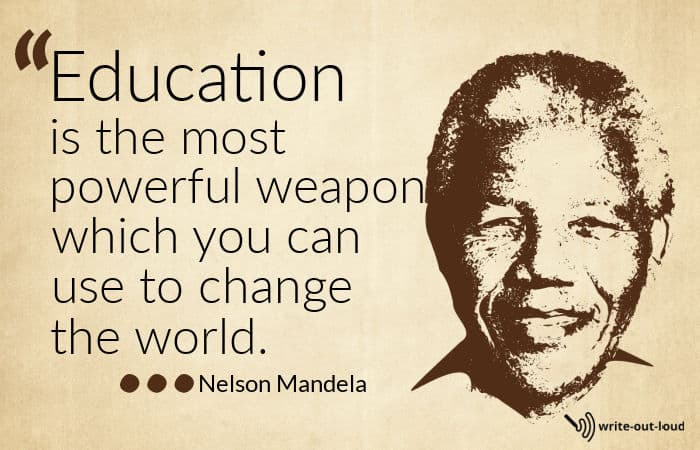
- that there is no such thing as the best form of education
- that some types of education are a waste of time and resources
- that all education should be free
- that education should be paid for by those who want or use it
- that schools should provide experienced specialist support teachers to meet the needs of all their pupils
- that no child should be denied an education on the grounds of gender, race, poverty or the legal status of their parents
- that online learning can never replace real-time and place class room learning
- that competition with other students is a necessary part of education
- that different learning styles need to be to be taken into account by teachers
- that a student who drops out of school has been failed by the school system
- that the problems created by illiteracy are bigger than we think
- that society benefits from promoting gender equality and women's empowerment through education
- that it is vital to teach media literacy to combat fake news and misinformation
- that scholarships for those who need them should be increased
- that a college education is not the right choice for everyone
- that private schools support elitism
- that the advantages of project-based learning far outweigh the disadvantages
- that having a bilingual education is an advantage in a globalized world
- that a good education is the passport to a better life
- that a school uniform helps make everyone equal
- that schools need to systematically teach critical thinking and problem-solving skills
- that teachers should be held responsible for the performance of their students
- that the students of a teacher who is enthusiastic about their topic will always achieve better grades
- that textbooks, and other school supplies, should be provided free of charge to those who need them
- that there needs to a comprehensive education program on consent and sexual assault prevention in schools
- that life skills, (how to cook, how to budget and manage money effectively, how to shop economically, how to garden...) should be taught in schools
- that making some school subjects compulsory should be abolished
- that coding and computer science should be taught from an early age
- that taking a gap year should be encouraged
- that an arts education fosters creativity and critical thinking
- that alternative forms of education should be encouraged, and supported
- that teachers should be thoroughly background checked
- that teachers should have to pass a regular 'fitness to teach' test
- that the school leaving age should be raised
- that students should not be forced to take classes they do not want to
- that there are significant advantages for using technology in the classroom
- that school violence is a mirror of the society we live in
- that students who take part in protests are actively learning about their rights and responsibilities
- that grades do not reflect intelligence
- that truancy is powerful comment on the relevancy of schools
- that homework, for homework's sake, should be banned
- that residential segregation has a direct impact on the quality of education students receive
- that prestigious schools maintain their prestige through only admitting students who are likely to succeed
- that schools should focus on the core subjects: reading, writing and arithmetic
- that parents should be far more involved in their children's education
- that a person who is homeschooled is not disadvantaged
- that far too much importance is placed on IQ tests
- that corporal punishment should never be used
- that meditation and other forms of mindfulness should be taught in schools
- that single sex schools are better for girls
- that intelligence is more than quick accurate recall and clever problem solving
- that a holistic education is best
- that an education should be a right, not a privilege
- that it is important to teach students about empathy and emotional intelligence
- that no girl should ever be barred from school because she is pregnant
- that there is no 'right, one way' to educate a child
- that bullying, in any form, by anyone, should be addressed immediately and appropriately
- that students need to be taught how to handle social media responsibly
- that the arts are equally as valuable as the sciences
- that an old-fashioned school curriculum teaches respect and values
- that it is advantageous to learn at least one other language, in addition to your mother tongue
- that the foundation of all education is laid down in the home
- that civics and ethics should be core subjects
- that extracurricular activities are an essential part of a well-rounded education
- that cheating on a test or in an examination is understandable
- that community service should be an essential part of education
- that financial education is essential and should be taught to all students in all schools
- that guns should never be taken to school
- that getting top marks in an examination is not the only way to prove a person’s intelligence
135 persuasive speech topics about health
Health, according to the World Health Organization , is "a state of complete physical, mental and social well-being and not merely the absence of disease and infirmity." It's a huge topic! And that is an understatement!
46 mental health persuasive speech topics

- that mental health should be taken more seriously by general health practitioners
- that mental health should be discussed in schools
- that mental health and physical health are interdependent
- that early intervention is important to prevent long-term mental health problems
- that good mental health begins with a good diet
- that being 'mad' does not mean a person is 'bad'
- that a person can learn to become more mentally resilient
- that to be vulnerable is to be strong
- that laughter heals
- that how the media portrays mental health issues influences public perception for better and for worse
- that mental health issues are passed down from generation to generation
- that mental health issues can unnecessarily limit what people choose to do with their lives
- that poverty and homelessness underpin many mental health issues
- that we need mental health screenings and regular check-ups to monitor our overall well-being
- that prolonged lack of sleep can cause mental health concerns
- that religious practices and beliefs can contribute to mental health problems
- that anxiety and depression need to be more widely understood
- that sticks and stones will break my bones, but names will never hurt me is a lie.
- that vacations are essential for good mental health
- that learning to live with mental health is very different from suffering from it
- that acknowledging our own struggles with mental health makes it easier to understand other people's
- that teachers need training to recognize symptoms of possible mental health issues in their students
- that there is a direct link between physical exercise and mental health
- that substance abuse can mask mental health issues
- that green environments promote good mental health
- that bullying can have serious consequences
- that the real reason a bully bullies is never the person who is being bullied by them
- that the impact of chronic pain on mental health needs to be more widely understood
- that negative self-worth beliefs are reflected in mental health problems
- that treatment for mental health issues should be fully integrated with any other health service providers
- that loneliness and isolation are often factors in mental health concerns
- that cultural difference can underpin mental health issues
- that being mentally unwell is not a sign of weakness
- that shaming a person for needing treatment for mental illness is both cruel and ignorant behavior
- that regular doom-scrolling significantly impacts on a person's mental health
- that overlooking symptoms of mental health problems is dangerous
- the pressure to 'fit in', to conform and to become someone else's idea of who you should be is unhealthy
- that seeking help for mental health concerns is a positive proactive thing to do
- that taking responsibility for our own mental wellbeing is vital
- that to be a little bit crazy is a good thing
- that understanding the cyclical link between addictive behaviors and mental health issues is critical to providing solutions
- that how we talk to ourselves, about ourselves, influences our state of mind
- that self-care and self-compassion are important for maintaining good mental health
- that the adverse impact of traumatic events on mental health is often ignored or underestimated
- that strategies for recovery from trauma and ongoing resilience should be taught in schools
- that peer support groups and community networks are an important part of a person's recovery because they provide a sense of belonging and support
For 50 more mental health persuasive speech topics
24 persuasive ideas: the psychology of motivation
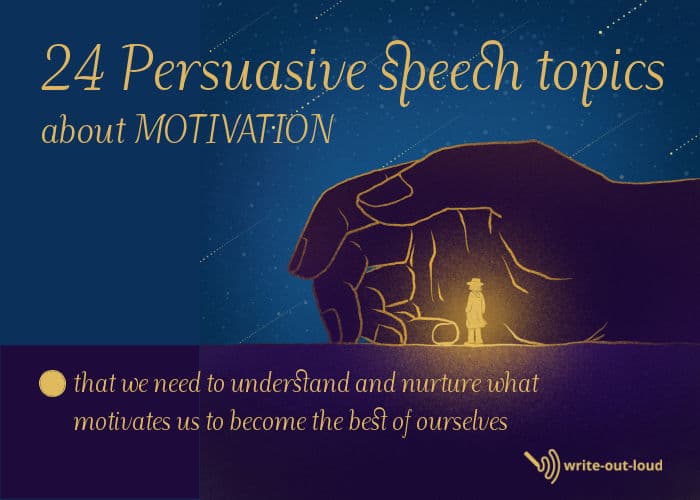
Why do people behave the way they do?
What makes one person deliriously happy when they're in front of a large group of people telling them what to do and another person, utterly miserable?
Why do some people absolutely have to have the latest widget-wodget? And why do others not think about widget-wodgets at all?
The answers are found in motivation.
Motivation is the driving force behind our behavior. It provides the explanation for what we do.
- that personal success is motivating
- that envy is a powerful motivator
- that 'Fear of Missing Out' (FOMO) motivates/influences people to do things regardless of whether they really want to or not
- that seeing success in significant others gives people the motivation to make positive changes
- that finding out what motivates a person at a fundamental level is key to persuading them to follow a certain course of action
- that social media is responsible for motivating people to strive for the unattainable
- that carefully selected strategies for motivating students lead them to excel in their studies.
- that fear of failure motivates many people
- that the desire to be better than others, and to be seen to be better, is a powerful motivator for many people
- that money makes the world go round: the need and desire for money motivates how we behave
- that desire for public recognition and acknowledgment is a powerful motivating force
- that the possibility and promise of becoming famous and powerful can motivate all sorts of extreme behavior
- that knowing what you do is helpful, useful, and kind is motivating
- that mindfulness practices increase personal motivation
- that the desire to understand a particular process or to solve a specific problem is the motivation behind most innovative developments and inventions
- that setting inspiring yet realistic goals motivate a person to strive to reach them
- that fear of consequences motivates people to continue to do what they would rather not
- that curiosity motivates exploration and experimentation
- that being motivated by the acquisition of material rewards, wealth and possessions, will ultimately not be enough
- that fear and anxiety motivate aggression
- that serving your community the best way you can is motivating
- that positive self-talk increases and sustains motivation
- that people are happiest and most creative when they motivated by what they are passionate about
- that being genuinely and sincerely proud of oneself is motivation to keep ourselves on track
- that we need to understand and nurture what motivates us to become the best of ourselves
For more information: Motivation and What Really Drives Human Behavior (positivepsychology.com)
10 persuasive speech topics about autism
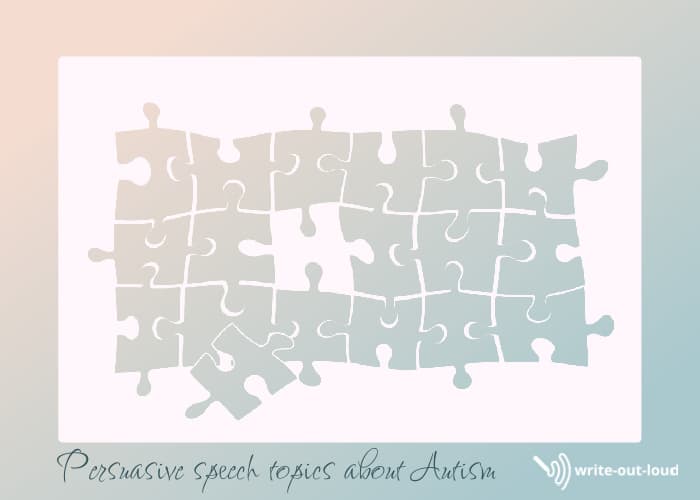
Autism, or autism spectrum disorder (ASD), refers to a broad range of mild to severe conditions characterized by challenges with social skills, repetitive behaviors, speech and nonverbal communication. A recent (2020) study revealed that 1 in 36 children (2.7%) in USA have been diagnosed with the disorder. And that number is increasing.
- that promoting autism awareness matters and makes a difference
- that early intervention and treatment is important
- that education for students with autism should be inclusive and supportive
- that the myths and stereotypes about autism need challenging
- that inclusive hiring practices and workplace accommodations are beneficial for everyone: employers and employees.
- that families affected by autism need accessible resources, services, and support systems.
- that technology plays an important role in enhancing communication for nonverbal individuals with autism.
- that ongoing research, and funding, is required to improve understanding and treatment options.
- that there needs to be a holistic approach to autism care.
- that individuals on autism spectrum have value and strengths just like any other person.
19 persuasive speech topics on natural medicine
The term 'natural medicine' is one of several used interchangeably to describe any medical product or practice that is not standard (conventional) medical care.
Other synonyms are:
- alternative medicine or therapies,
- holistic medicine which implies taking into account the 'whole' person rather than focusing on and treating isolated symptoms,
- herbal (plant based) remedies and,
- complementary medicine: a treatment regime that includes elements of conventional and alternative medical care.
'Natural medicine' polarizes people. There are those who are vehemently against any form of it and who will not consider any treatment other than what is current standard medical practice. Then there are those who resolutely choose alternative options. Either way, it's a fascinating field!

- that traditional herbal remedies effectively treat common ailments
- that acupuncture is beneficial for pain management
- that practicing meditation and mindfulness improves mental health
- that chiropractic treatments effectively relieve back and neck pain
- that yoga supports physical and mental wellness
- that naturopathy should be used as a complementary approach to conventional medicine.
- that homeopathy is effective in treating chronic illnesses.
- that aromatherapy can relieve stress and enhance relaxation.
- that traditional Chinese medicine should be incorporated into modern healthcare.
- that good nutrition prevents disease
- that massage therapy promotes physical and mental well-being.
- that energy healing treatments like Reiki and acupuncture work well
- that CBD (cannabidiol) oil helps people effectively manage pain and anxiety.
- that the advantages of integrative medicine: combining conventional and alternative approaches should not be underestimated
- that herbal supplements support good immune system health.
- that holistic Ayurvedic medicine and practices are proven and promote wellness.
- that the common myths about alternative health care and its potential harms are overstated
- that acupuncture is an effective fertility treatment
- that hypnotherapy is an effective treatment for public speaking fear, smoking cessation, weight loss, and more...
14 persuasive speech topics on the possible dangers of using alternative medicine
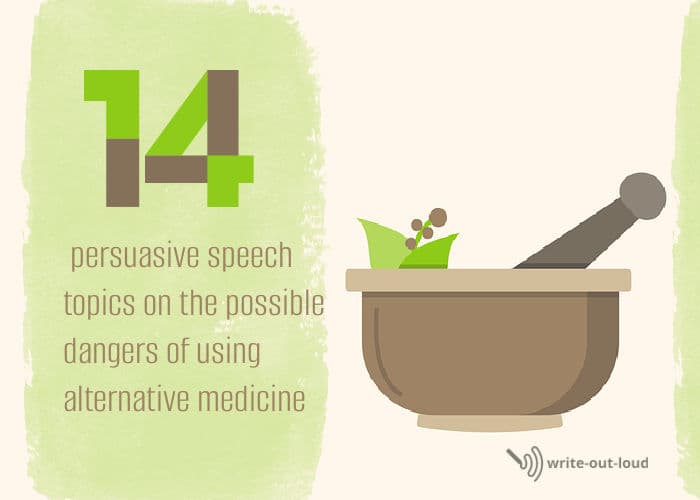
- that there are hidden risks in using unregulated alternative health care practices
- that there are potential dangers in relying solely on alternative health care for serious medical conditions
- that there are risks in self-diagnosis and self-treatment with alternative health care
- that misinformation is a problem in alternative health care practices
- that there are potential adverse effects with unproven alternative health care treatments
- that there are hidden financial risks with alternative health care therapies
- that evidence-based medicine is more reliable than alternative health care approaches
- that we need to protect vulnerable people from the dangers of untested alternative health care remedies
- that unqualified practitioners in alternative health care fields can cause harm
- that relying on unverified testimonials and anecdotal evidence in alternative health care is dangerous
- that there are risks of negative interactions with conventional medications while using alternative health care treatments
- that unregulated supplements and herbal remedies in alternative health care could be dangerous
- that alternative health care therapies for incurable diseases promote false hopes
- that informed consent and transparency in alternative health care practices is important
22 current medical issues speech topics
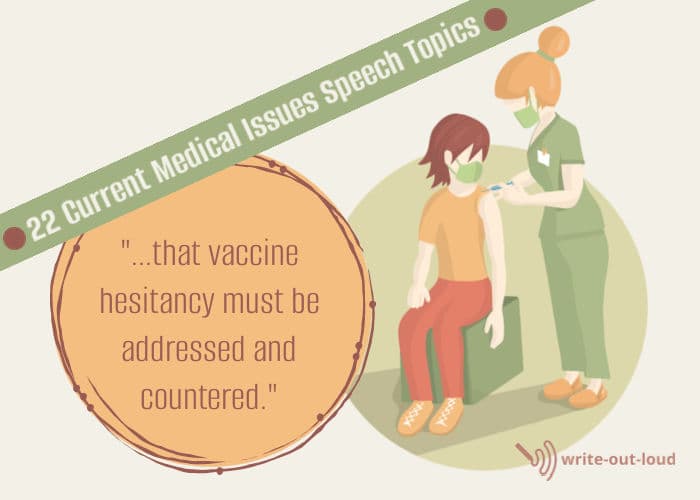
- that vaccine hesitancy must be addressed and countered
- that stigmas around mental health must be challenged
- that good accessible mental health care should be available for all
- that cosmetic and reconstructive surgery should only be for those who genuinely need it
- that comprehensive specialized mental health programs and support systems need to in schools
- that the lessons for the opioid crisis must be learned
- that inequal access to medical services needs addressing
- that the balance between patient autonomy and a physician's responsibility needs careful monitoring
- that strategies for promoting healthy aging and elderly care are essential with an aging population
- that organ donation needs to be actively encouraged to overcome the shortage of organs available for transplantation
- that the ethical implications of genetic testing need careful consideration
- that healthy active lifestyles must be promoted to combat childhood obesity and the obesity epidemic
- that the increasing role of technology in healthcare presents as many innovations as it does challenges
- that pharmaceutical drugs need to be accessible and affordably priced
- that the impact of social media on body image need to be countered by actively promoting positive self-perception
- that developing countries need support to improve health care infrastructure and access
- that precision medicine or personalized healthcare has better patient outcomes
- that we should encourage conversations about end-of-life care before the need for it arises
- that the legal and ethical concerns about euthanasia and assisted suicide can be humanely and respectfully resolved
- that the use of Artificial Intelligence (AI) in medicine presents great opportunities as well as challenges
- that improving obstetric care would lower maternal mortality rates
- that for the good of the health of the mother, abortion on demand should be legal
- that all tobacco products should be banned
- that the use of medical marijuana by patients in hospitals needs careful consideration from a legal standpoint
The subject of food: its cultivation, preparation, scarcity or abundance, generates passionate debate regardless of who we are, or where we are on the planet.
Have fun with these!
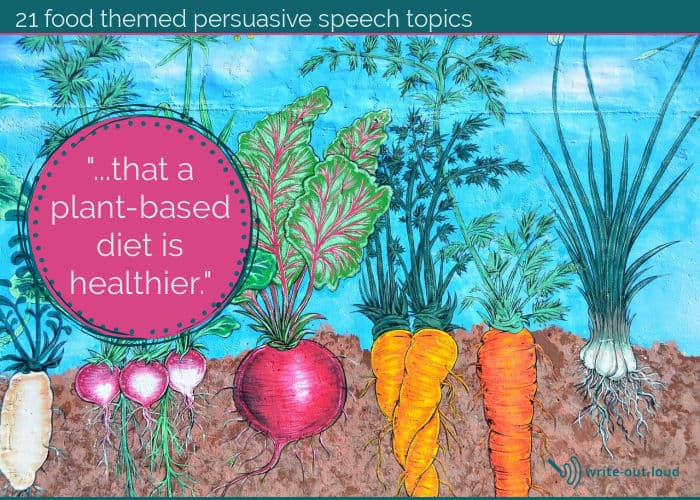
- that poor nutritional health in first world countries is the result of poor food choices
- that the use of unsustainably produced palm oil in food and other products should be banned
- that the benefits of eating locally sourced food outweigh the disadvantages
- that we must reduce food waste to lessen its environmental impact
- that eating fast food long-term is dangerous
- that a plant-based diet is healthier
- that the negative effects of genetically modified organisms (GMOs) in our food system outstrip their shorter term benefits
- that organic farming has positive effects on health and the environment
- that nutrition education in schools helps combat childhood obesity
- that a sugar tax would help control the consumption of foods with high sugar content
- that factory farming is unethical
- that we need to adopt humane animal welfare practices
- that advertising and marketing of unhealthy food choices makes them attractive
- that food safety and strictly enforced regulations are necessary for public health
- that food waste should be against the law
- that food deserts (areas that have limited access to affordable and nutritious food) have an enormous impact on the health of communities
- that there are workable, sustainable, affordable strategies to combat the effects of food deserts and food insecurity
- that the food we eat effects our mental as well as our physical health
- that producing food sustainably helps combat climate change
- that there are significant health risks associated artificial food additives and preservatives
- that genetically modified foods must be labeled for consumer awareness
53 topics: ethics, morals and values
The words 'ethics', 'morals' and 'values' are frequently interchanged as if they mean the same thing. However, although there is considerable overlap between them, they don't.

Values are the core beliefs on which we center and base our lives. They are the values we have decided are important and can be personal as well as shared. Examples are honesty, service, cooperation, family, heritage, freedom of expression, independence, privacy, loyalty, integrity, or success.
Morals are based on our values. They elicit feeling or emotional responses in us. For instance, we feel good when we behave in accordance with our values, and bad when we don't. Like values, our moral codes can be either personal or shared.
For example: if one of our core values is the importance of family, then we will feel guilty and uncomfortable if we don't honor it. We make a moral judgment about our own behavior.
Ethics : These let us know what is right and wrong. For instance, many professions have a code of ethics to regulate the behavior of their members. Examples are medical practitioners, lawyers, and teachers. They are rules based on a shared moral code as are the laws governing how we function as a society.
Because life and people's experience of it, is not static, values, morals and ethics can change over time. And although there are some behaviors that have generally always been unlawful, (murder, fraud, infanticide...), what was acceptable and normal once, does not guarantee its rightness now.
For a fuller explanation please see this excellent article: What's the Difference Between Ethics, Morals and Values?
28 topics based on morals and ethics
- that there are major ethical implications of the role of artificial intelligence in our daily lives
- that the unmonitored use of facial recognition technology is a violation of individual rights
- that corporations have a moral responsibility to address climate change
- that war is never right ethically or morally
- that the ethics of genetic engineering and its impact on society need careful monitoring
- that it is important to fully consider the ethics in the development and use of emerging technologies like blockchain and cryptocurrency need
- that the ethical challenges of data privacy and protection in the digital age must be met for the safety and security of society
- that the ethical implications of using animals for scientific research requires regular reviewing
- that the ethical and moral implications of our current abortion laws need thorough and careful investigation
- that the ethics of capital punishment need scrutinizing. Is it ever morally justifiable?
- that the ethical implications and long-term impact of gene editing and designer babies need careful consideration
- that it is no longer either ethical or moral to differentiate salaries or workplace benefits on the basis of gender
- that the moral obligations of healthcare professionals in end-of-life decisions need to be fully considered
- that whistleblowing is an ethical way of ensuring corporate accountability
- that the use of drones and autonomous weapons demands a thorough review of the ethical considerations involved
- that an individual has the right to choose their own death. The moral dilemma of euthanasia, if there is one, is their own to solve.
- that the ethical implications of the long-term impacts of genetic testing and personalized medicine need to be thoroughly investigated
- that social media platforms have ethical responsibilities in combating the spread of online harassment and misinformation
- that the moral issues surrounding the use of performance-enhancing drugs in sports need to examined calmly and carefully
- that the ethics of factory farming and its impact on animal welfare need to be thoroughly and regularly reviewed
- that the ethical and moral implication of discriminatory adoption laws should be investigated
- that the ethics and impact of online advertising should be independently monitored
- that the ethical considerations in the allocation of healthcare resources should always play a major role in decision making
- that the moral implications of genetic cloning and its potential consequences will force our governing bodies to legislate against it
- that the ethics of global wealth distribution and poverty alleviation will always be in question while inequality exists
- that the ethical challenges of conducting research on human subjects is entirely justifiable
- that internet censorship is both sensible and ethical
- that it is ethical and morally responsible that children should have their use of social media and the internet monitored.
25 persuasive speech topic ideas on values
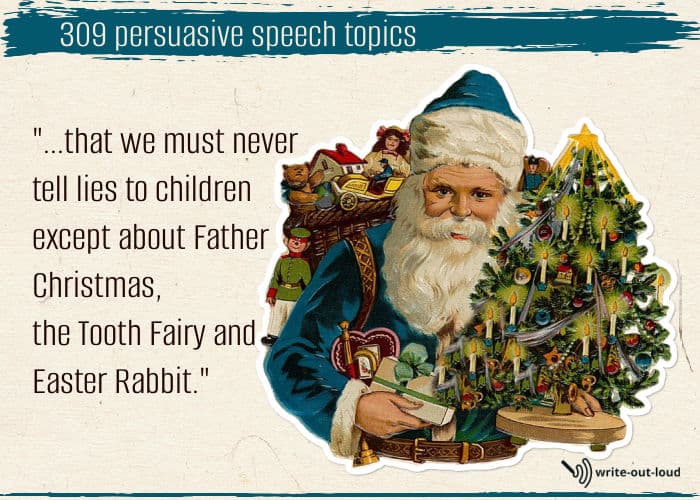
- that we must never tell lies to children except about Father Christmas, the Tooth Fairy and the Easter Rabbit
- that honesty in personal and professional relationships is best at all times
- that embracing diversity is essential for a harmonious society
- that team sports build good character traits
- that empathy, (compassion and understanding), has the power to change lives
- that education is fundamental for personal growth and the progress of society
- that privacy and the protection of personal information matters more than ever
- that everybody is entitled to privacy, including children and teenagers
- that taking personal responsibility and promoting sustainability for our planet's environment is vital for our and its survival
- that actively advocating for gender, racial and social justice promotes equality
- that life was better before the influence of online social media took over
- that everyone should spend several months per year working for the betterment of others in a non-profit social service organization
- that regular acts of kindness and goodwill make a positive impact no matter how small
- that becoming self-aware increases our emotional intelligence, which in turn, improves our relationships with others
- that the lives of all living creatures should be valued and protected
- that we need to celebrate, tolerate and accept differences in beliefs, cultures and lifestyles
- that expressing oneself freely is more important than getting the grammar, punctuation and spelling right
- that integrity, honoring moral principles, in personal and professional settings, builds trust and respect
- that cooperation, volunteering and civic engagement builds strong healthy communities
- that everybody should learn to cook and clean for themselves
- that we need to value, understand and learn from our history
- that genuinely and sincerely acknowledging and apologizing for hurtful, damaging behavior promotes healing and encourages transformation
- that it is better to earn your own living rather than to be financially provided for by someone else
- that money is not a meaningful measure of success
20 persuasive speech topics about the economy
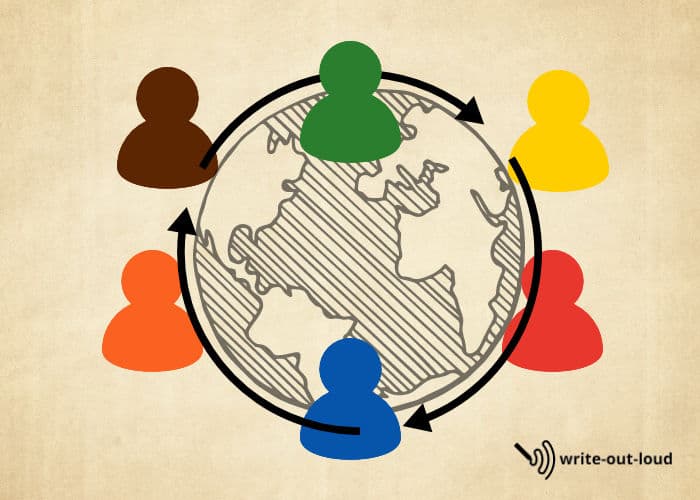
What is an 'economy'? What does the word mean? I hear and read it frequently and its often in different contexts.
For example, at my local grocery store there's a large sign telling me that buying 10 cakes of soap at a never to be repeated discounted rate of 33% off per cake is good economy.
On the news I hear that our economy is challenging. There have been significant rises in the price of food over the past six months and mortgage rates are set to increase.
That's two different uses. The first is implying that buying in bulk will save me money. The second suggests it refers to the ebb and flow of monetary exchange for goods and services in society.
I sought a definition for clarity and found this:
"An economy is a complex system of interrelated production, consumption, and exchange activities that ultimately determines how resources are allocated among all the participants. The production, consumption, and distribution of goods and services combine to fulfill the needs of those living and operating within the economy.
An economy may represent a nation, a region, a single industry, or even a family."
For more information: Economy: What It Is, Types of Economies, Economic Indicators (investopedia.com)
This definition covers the dynamic interconnecting web of exchanges for goods and services underpinning our daily lives, and that is the focus of the topics below.
- that promoting entrepreneurship for economic growth has benefits
- that investing in renewable energy for a sustainable economy is important
- that there are both advantages and disadvantages of globalization on national economies
- that the impact of automation on employment requires carefully thought through strategies for economic adaptation.
- that multinational corporations need stricter regulations
- that increasing the minimum wage to improve income equality benefits everyone
- that the advantages of a universal basic income for economic stability outweigh its disadvantages
- that government should play an active role in fostering innovation and technological advancements
- that financial literacy education benefits both individuals and the economy
- that promoting fair trade practices benefits developing economies
- that income inequality impacts on social stability and economic growth
- that free trade agreements have significant advantages
- that investing in infrastructure for economic development is important
- that implementing sustainable economic policies has benefits for long-term growth
- that government has a role in reducing poverty and income disparities
- that immigration and inclusive immigration policies have a positive impact on the economy
- that the advantages of austerity measures during economic crises outweigh the disadvantages
- that promoting small businesses is important for local economic development
- that investing in education and skills training benefits economic competitiveness
- that technology transforms traditional industries and creates new economic opportunities

More persuasive speech resources
Persuasive speech topics.

- 105 fun persuasive speech topics : ideal for light-hearted, informal speeches
- 100 non-boring persuasive speech ideas - a 'tired' topic is not for you. Choose something fresh and original.
- 50 good persuasive speech topics with treatment examples to show you how the same topic is treated differently for different audiences.
- 310 persuasive speech topics for college : mental health, society, family & friends, animals, education
- 108 feminist persuasive speech topics : the top current women's rights & feminist issues
For assistance with planning and writing
- Writing a persuasive speech - a 7 step action plan that includes how to choose a topic, analyze your audience, set a good speech purpose, decide on a structural pattern (with examples) and, more.
- A persuasive speech outline example using the 5 step structural pattern: Monroe's Motivated Sequence. (With a free printable outline)
- A persuasive speech example using Monroe's Motivated Sequence
speaking out loud
Subscribe for FREE weekly alerts about what's new For more see speaking out loud

Top 10 popular pages
- Welcome speech
- Demonstration speech topics
- Impromptu speech topic cards
- Thank you quotes
- Impromptu public speaking topics
- Farewell speeches
- Phrases for welcome speeches
- Student council speeches
- Free sample eulogies
From fear to fun in 28 ways
A complete one stop resource to scuttle fear in the best of all possible ways - with laughter.

Useful pages
- Search this site
- About me & Contact
- Blogging Aloud
- Free e-course
- Privacy policy
©Copyright 2006-24 www.write-out-loud.com
Designed and built by Clickstream Designs
Home Blog Presentation Ideas Persuasive Speech: Actionable Writing Tips and Sample Topics
Persuasive Speech: Actionable Writing Tips and Sample Topics
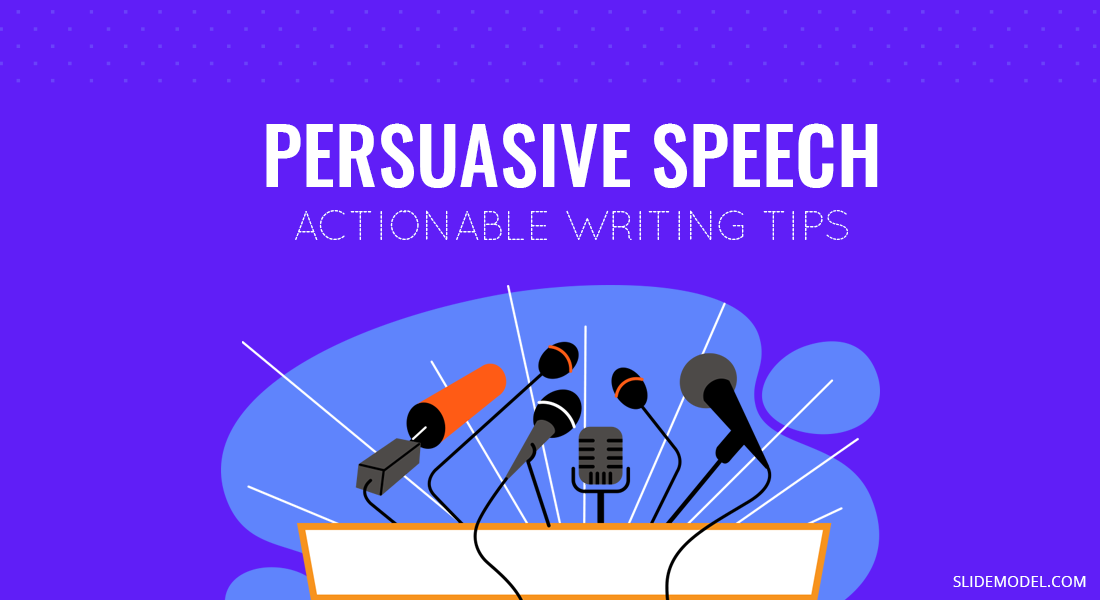
What is Persuasive Speaking?
Factual persuasive speech, value persuasive speech, policy persuasive speech, how to start a persuasive speech: opening tips and examples.
- Social Proof
- Comparisons
- Agitate and Solve
- Storytelling
Bonus: Address Counter Arguments
How to close your persuasive speech: quick examples, easy persuasive speech topics, interesting persuasive speech topics, good persuasive speech topics on controversial issues, funny persuasive speech topics, designing persuasive visuals: slide elements for maximum impact, mastering delivery techniques: engaging body language and voice modulation, persuasive presentation structures: organizing your content for maximum influence, handling audience interaction: q&a sessions and audience engagement, persuasive call to action: inspiring and motivating your audience to act.
Business professionals, students, and others can all benefit from learning the principles of persuasive speech. After all, the art of persuasion can be applied to any area of life where getting people to agree with you is important. So without much further ado, let’s get into the basics of persuasive speaking, persuasive speech writing, and lastly persuasive speech topics!
A persuasive speech is a specific type of speech where the presenter attempts to convince the audience of their point of view. The ideal goal of a persuasive speech is to make the audience change their mind on the issue, or at least, become more accepting of their point of view.
You might give an informal persuasive speech when trying to convince your friends to agree to the movie you want to watch. If you are chosen to pitch a new product idea to stakeholders at work, you are essentially being asked to give a persuasive speech.
What are The 3 Types of Persuasive Speeches?
All the persuasive speech ideas can be organized into one of the next three categories:
When someone gives a factual persuasive speech, their goal is to convince the audience that something is true or false. In some cases that simply requires gathering evidence and presenting them in the form of arguments/counter-arguments. This approach works for all persuasive topics where true/false is a binary consideration.
You can also give a factual speech on a topic that isn’t as cut and dried. For example, you could make the argument that assimilation is the best way for cultures to mix even though there is no single piece of evidence proving that without a doubt.
In essence, you can select any topic and frame it into the factual persuasive speech as long as you have strong oratory and presentation skills .
In this case, you are trying to convince your audience that something is good or bad. You want your audience to understand your values on a topic, and then adopt those values as their own. For example, a speech written to convince people that it’s immoral to buy single-use plastics is a value persuasive speech.
In a policy persuasive speech, you describe a problem, then work to persuade the audience to agree with your proposed solutions. These speeches can be given to simply change the audiences perspective or convince them to take a specific action.
Policy persuasive speeches can be further spiced up with some nuggets of Nudge Theory to reinforce the idea you are trying to deliver.
How to Write a Persuasive Speech: The Essential Steps
Before we dive deep into the writing, let’s quickly recap the anatomy of a persuasive speech:
- Opening: start strong to capture the audiences attention and explain your agenda.
- Key arguments: present your key talking points and lay down the facts.
- Counterpoints: address the common objections.
- Closure: recap your key message once again and suggest further action.
Now, this isn’t a “set-in-stone” structure, but rather a base you can use when drafting your persuasive speech outline.
Below we are listing some extra tips for each section, along with persuasive speech examples.
Every good speech and presentation need a strong opening slide . After all, how can you persuade anyone if they do not feel compelled to listen to you in the first place? Right, you can’t and that’s exactly why you should spend quite a lot of time working and refining on your speech opening.
Here are some techniques you can try:
- Start with a curious personal story/anecdote
- Sharing a surprising statistic
Next, you must convince the audience that they should listen to you. You can do this by explaining what you have in common.
For example, Everyone here is a concerned parent. I am also a mother of three who cares deeply about the lack of interest in STEM among girls. This is also where you might share your credentials. That’s why I’m here to speak to you as a professional with 30 years of experience as an educator.
Follow your intro statement with a quick explanation of your goal. Be direct here. In one or two sentences state your purpose, and what you want your audience to believe or do.
“I believe that women in STEM can close the looming tech skills gap and generate an extra $12 trillion in global GDP. That’s why I’m asking you to stop encouraging girls to learn dancing and encourage them to code instead.”
Finally, transition to the main part of your speech with a statement that lets the audience know what is coming. For example, Today, I am going to provide you with the evidence that some parental practices are alienating girls from STEM subjects.
Liked this primer? Great! Here are several more techniques you can use to frame your ideas for persuasive speeches.
What are The 5 Persuasive Techniques?
After the opening, it’s time to present your arguments and counter any arguments that could conflict with your point. The following five persuasive techniques tend to work like a charm for that purpose:
- Social proof
- Agitate and solve
More controversial persuasive speech topics, in particular, will require you to artfully work through various objections and mix different persuasion methods. Now let’s take a closer look at each one.

1. Repetition
There’s a reason that advertisements repeat the same thing over and over again. Research proves that people are more likely to believe something if they hear it multiple times. In addition to this, repetition simply helps people to remember key points that you want to stick with them.
When it comes to persuasive speeches, you should always repeat your most important points at the beginning and end of your speech.
Helpful template: 6 Steps Hexagonal Segmented Diagram

2. Social Proof
People are influenced by the actions and beliefs of others, whether they admit it or not. Use this during your speech. For example, you can share testimonials from people who agree with your POV or leverage the voice of customer data , expressing the same concerns as you do.
NB : When lining up social proof for your presentation, make sure that this data comes from a peer group that your audience relates to.
Helpful template: Voice of customer PowerPoint template

3. Comparisons
The point of using comparisons is to present a contrast of the idea/element that you support with the one that you do not. Then you’ll need to prove that yours is the best choice. For example, you might compare the features of two software applications to persuade that your team needs option A, not B.
Using comparisons also gives your speech more credibility since it appears that you are giving the opposing position a fair shake, even when you are only showcasing it to score points against it.
Helpful template: Two option comparison template

4. Agitate and Solve
When you take the “agitate and solve” approach, you first make your audience vary and somewhat dissatisfied with a certain issue (agitate). Next, you present your idea as a solution (solve). The idea is to hit a nerve and get the audience to relate. Then, when you present your solution, it’s that much more persuasive to them. It also makes the entire scenario more emotionally compelling to them.
Here’s an example of this approach in action:
Nearly every one of us has been ripped off by an unscrupulous mechanic. Nobody deserves to be taken advantage of. That’s why every person needs to vote in favor of this consumer protection ballot measure.

5. Storytelling
Many people opt to use a rhetorical triangle when building their persuasive argument s. These days storytelling may be more effective. Here’s why:
Stories create an emotional connection and relatability. Imagine listening to a speech where the speaker lists a variety of statistics about the harm that plastics cause to marine life. Now, imagine listening to the true story of a marine biologist who discovers a dolphin that has been badly injured by plastic trash it has encountered in its habitat.
Clearly, the second one, if told correctly, will cast a much deeper impact on the audience.
Helpful template: Storytelling theme template .

It’s up to you to decide if you want to address any counterpoints to your arguments, and where you will do that in your speech. Some speakers choose to include an obvious counter-argument in the introduction, so they can effectively dismiss it before they begin.
Others address these points when they are relevant to the current argument they are making. Finally, you can address a counterpoint in its paragraph just above your concluding paragraph.
Here are some actionable techniques for addressing counter-arguments:
- Provide a direct refutation of the point. Prove that it simply isn’t an issue.
- Concede that it’s an issue, but show that it isn’t significant enough to derail your overall argument.
- Acknowledge the plausibility of the counterpoint, but argue yours as the better option.
Recommended Reading: Building a Persuasive Argument with the Rhetorical Triangle Concept
How you present your closing depends on your goal. If you want your audience to take a specific action, show them how to do it, and make it as easy as possible. Try this:
When you pay your trash bill next month, you’ll be asked if you want the city of Gravesdale to begin a recycling program. If you value water quality and marine life, please say yes.
If your goal is to simply influence a change in opinion, you might say: Both facts and experience prove that we can no longer afford to send plastics to the landfill. Please consider this the next time you go shopping.
Alright, now you may be wondering: what are the best persuasive speech topics? We’ve got you covered here too!
A List of Persuasive Speech Topics
Here is a list of persuasive speech topic examples, with writing tips .
The easiest topic to present on is the one that you are truly passionate and knowledgeable about. Also, easy persuasive speech topics usually don’t tackle any controversial issues with a lot of contrarian opinions, especially on complex matters regarding politics, religion, human rights, and so on. Instead, you choose an angle that may already resonate with a good fraction of your audience and require one or two good counterarguments, rather than using a host of persuasive techniques.
For example : Should all internships be paid?
Most people will instinctively say yes , especially if your audience consists of college graduates and former interns.
What makes an interesting speech? Topical ideas that get people engaged, agitated, and eager to follow your storyline.
In this case, you’d want to find a deeper subject that allows you to incorporate some storytelling elements and personal examples that would create some empathy with the audience and make them relate to your cause on a more personal level. As Lucinda Beaman, fact check editor at The Conversation said in her Ted talk :
“While you are listening to your opponent’s case, you are probably listening for an opportunity to refuse them”.
A quality narrative can help you draw your opponent’s attention from their counterarguments and, instead, make them more sympathetic to your cause.
For example : Schools kill creativity. As a former drop-out, turned CEO of the Fortune 100 company, I can tell you why.
If you are ready to pick a bigger ‘fight’ with your audience, you may tackle a more complex and controversial issue that’s dividing the audience. In such cases, it’s best to rely on a mix of persuasive techniques:
- Start with a strong opening, drawing the line in the sand
- Line up social proof and data points to bake your key arguments
- Rally people to understand your point of view and why you feel the way you do
- Precisely address the common counterarguments on the matter.
For example : It’s time to realize that marijuana legalization is wrong.
Your opponents will argue that legalization reduces criminalization around the selling of marijuana, plus medical marijuana usage does help certain patient groups cope with their illness better. Acknowledge these ideas in your speech, but also provide extra facts that can speak to the opposite.
Did you know that humor itself is a powerful persuasive technique? That’s why it’s often used in advertising. Choosing a funny angle and topic for your persuasive speech is a sleek move if you know that you can really pull it off without offending anyone or downplaying the importance of the issue you are discussing.
For example: Millennials are definitely from outer space and our workplace isn’t ready for them.
You can start with a funny opening:
Millennials constantly chew on that weird greenish sandwich type of thing that they lovingly call the ‘avo toast’ and their fingers move inhumanly fast when they type things on their smartphones, amiright?
But that switch to a more serious accord:
But no matter how weird these Millennial folks may seem to us, boomers, they are a wonderful asset to every workplace. And we must make their point of few count, too!
- Crafting persuasive presentations goes beyond words alone. Designing persuasive visuals is a strategic approach to captivate your audience and enhance your message’s impact.
- Choosing Appropriate Visuals, Images, and Infographics: Select visuals that resonate with your message. High-quality images and relevant infographics can reinforce your points and aid audience comprehension.
- Using Color Psychology and Font Selection: Utilize colors that evoke desired emotions and align with your message’s tone. Choose fonts that are easily readable and complement your presentation’s aesthetics.
- Balancing Simplicity and Complexity: Strike a balance between simplicity and complexity in your slide content. Avoid overwhelming visuals while ensuring that complex concepts are presented clearly and succinctly.
- The art of persuasion extends beyond content to encompass delivery. Engaging body language and voice modulation play a pivotal role in conveying credibility and connecting with your audience.
- Significance of Body Language: Body language is a potent nonverbal tool. It influences the audience’s perception of your confidence, sincerity, and authority.
- Gestures, Eye Contact, and Posture: Employ purposeful gestures, maintain consistent eye contact, and exhibit a confident posture to establish rapport and engage the audience.
- Role of Vocal Variety, Tone, and Pacing: Utilize vocal variety to sustain audience interest. Vary your tone and pacing to emphasize key points, maintain engagement, and prevent monotony.
- Rehearsal Methods: Effective rehearsal hones your delivery skills. Practice your presentation multiple times to refine your speaking style, enhance clarity, and ensure a polished performance.
- Structuring your persuasive presentation optimally enhances its influence. Effective organization guides the audience’s understanding and reinforces your key arguments.
- Analyzing Different Presentation Structures: Choose a structure that aligns with your persuasive objectives. Sequential, problem-solution, comparative, or chronological structures can be tailored to your message.
- Crafting a Compelling Introduction: Your introduction should immediately grab attention. Use anecdotes, intriguing questions, statistics, or powerful quotes to pique interest and set the stage.
- Logical and Coherent Organization: Organize your arguments logically. Each argument should flow naturally into the next, creating a cohesive narrative reinforcing your persuasive case.
- Incorporating Emotional Appeals and Logical Reasoning: Blend emotional appeals with logical reasoning. Use relatable anecdotes, emotional stories, and compelling data to substantiate your points.
- Effective handling of audience interaction involves: Interacting with your audience during a persuasive presentation enhances engagement and reinforces your message.
- Preparing for Q&A Sessions: Anticipate potential questions and challenges. Prepare concise and confident responses to reinforce your message’s credibility.
- Techniques for Active Audience Engagement: Encourage audience participation through questions, discussions, and interactive activities. Engaged audiences are more likely to internalize your persuasive message.
- Using Audience Feedback and Questions: Leverage audience feedback and questions to enhance your presentation. Address concerns, clarify points, and demonstrate your expertise through thoughtful responses.
- Strategies for Adapting to Audience Reactions: Remain adaptable to audience reactions. Gauge their responses and adjust your delivery in real time to maintain engagement and address uncertainties.
- Concluding your persuasive presentation with a compelling call to action (CTA) is pivotal for motivating the desired response from your audience.
- Essential Elements of an Effective CTA: Craft a concise and impactful CTA that aligns with your presentation’s goals. Clearly communicate the desired action and its benefits to the audience.
- Crafting Persuasive and Actionable CTAs: Frame your CTA using persuasive language that resonates with your audience. Ensure the CTA’s feasibility and relevance to increase audience commitment.
- Techniques for Memorable and Compelling CTAs: Employ rhetoric, vivid imagery, and emotional appeal in your CTA. Make it memorable by creating a strong emotional connection that resonates with the audience.
- Measuring CTA Success and Tracking Audience Responses: Assess the effectiveness of your CTA through measurable outcomes. Monitor audience responses, track engagement, and gather feedback to evaluate success.
If you know how to give a convincing persuasive speech, you will be at a real advantage both in your personal life and at work! Commit the tips above to memory and start practicing on some of the good speech topics we’ve listed here to polish your tradecraft!
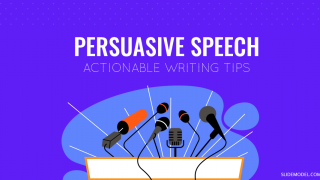
Like this article? Please share
Agitate and Solve, Convincing Speech, Funny Speech, Influence, Persuasive Speech, Public Speaking, Repetition, Social Proof, Storytelling Filed under Presentation Ideas
Related Articles
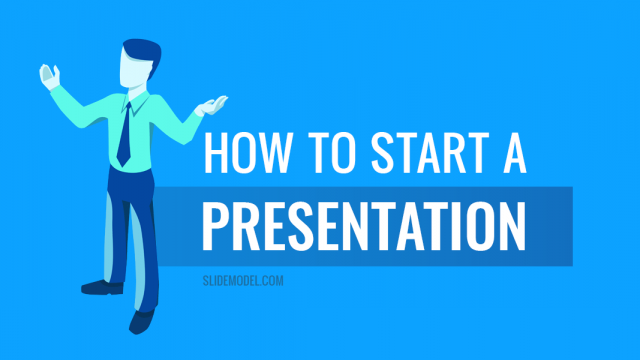
Filed under Presentation Ideas • November 8th, 2023
How to Start a Presentation: 5 Strong Opening Slides and 12 Tricks To Test
If you are looking for powerful techniques to engage your audience, learn how to start a presentation with this detailed guide. Success guaranteed!
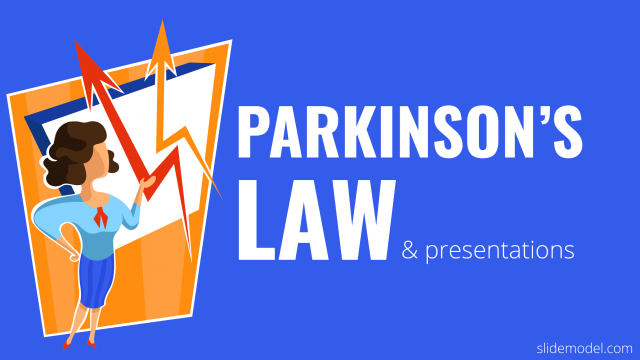
Filed under Presentation Ideas • August 5th, 2023
How Parkinson’s Law Can Make Your Presentations Better
Sometimes even the best presenters procrastinate their work until the very last moment. And then, suddenly, they get a flow of ideas to complete their slide deck and present like they have been preparing for it for ages. However, doing so has drawbacks, as even professional presenters cannot always elude the side effects of […]
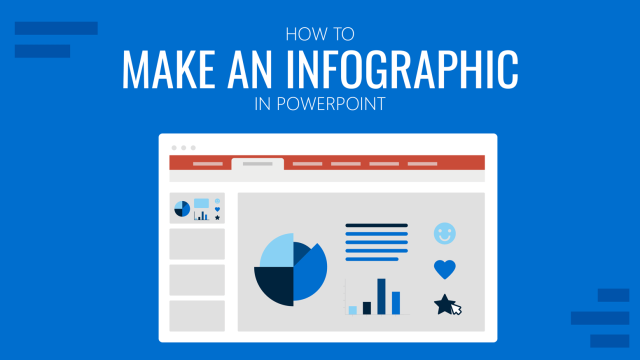
Filed under Presentation Ideas • November 10th, 2022
How to Make an Infographic in PowerPoint
In case you wonder how to create powerful infographics in PowerPoint, this is your guide to check. We will discuss the definition of infographic, its different types, how to construct an infographic, and real-case applications. If that weren’t enough, we also listed tips on how to improve infographics.
Leave a Reply

Improve your practice.
Enhance your soft skills with a range of award-winning courses.
75 Persuasive Speech Topics and Ideas
October 4, 2018 - Gini Beqiri
To write a captivating and persuasive speech you must first decide on a topic that will engage, inform and also persuade the audience. We have discussed how to choose a topic and we have provided a list of speech ideas covering a wide range of categories.
What is persuasive speech?
The aim of a persuasive speech is to inform, educate and convince or motivate an audience to do something. You are essentially trying to sway the audience to adopt your own viewpoint.
The best persuasive speech topics are thought-provoking, daring and have a clear opinion. You should speak about something you are knowledgeable about and can argue your opinion for, as well as objectively discuss counter-arguments.
How to choose a topic for your speech
It’s not easy picking a topic for your speech as there are many options so consider the following factors when deciding.
Familiarity
Topics that you’re familiar with will make it easier to prepare for the speech.
It’s best if you decide on a topic in which you have a genuine interest in because you’ll be doing lots of research on it and if it’s something you enjoy the process will be significantly easier and more enjoyable. The audience will also see this enthusiasm when you’re presenting which will make the speech more persuasive.
The audience’s interest
The audience must care about the topic. You don’t want to lose their attention so choose something you think they’ll be interested in hearing about.
Consider choosing a topic that allows you to be more descriptive because this allows the audience to visualize which consequently helps persuade them.
Not overdone
When people have heard about a topic repeatedly they’re less likely to listen to you as it doesn’t interest them anymore. Avoid cliché or overdone topics as it’s difficult to maintain your audience’s attention because they feel like they’ve heard it all before.
An exception to this would be if you had new viewpoints or new facts to share. If this is the case then ensure you clarify early in your speech that you have unique views or information on the topic.
Emotional topics
Emotions are motivators so the audience is more likely to be persuaded and act on your requests if you present an emotional topic.
People like hearing about issues that affect them or their community, country etc. They find these topics more relatable which means they find them more interesting. Look at local issues and news to discover these topics.
Desired outcome
What do you want your audience to do as a result of your speech? Use this as a guide to choosing your topic, for example, maybe you want people to recycle more so you present a speech on the effect of microplastics in the ocean.

Persuasive speech topics
Lots of timely persuasive topics can be found using social media, the radio, TV and newspapers. We have compiled a list of 75 persuasive speech topic ideas covering a wide range of categories.
Some of the topics also fall into other categories and we have posed the topics as questions so they can be easily adapted into statements to suit your own viewpoint.
- Should pets be adopted rather than bought from a breeder?
- Should wild animals be tamed?
- Should people be allowed to own exotic animals like monkeys?
- Should all zoos and aquariums be closed?
Arts/Culture
- Should art and music therapy be covered by health insurance?
- Should graffiti be considered art?
- Should all students be required to learn an instrument in school?
- Should automobile drivers be required to take a test every three years?
- Are sports cars dangerous?
- Should bicycles share the roads with cars?
- Should bicycle riders be required by law to always wear helmets?
Business and economy
- Do introverts make great leaders?
- Does owning a business leave you feeling isolated?
- What is to blame for the rise in energy prices?
- Does hiring cheaper foreign employees hurt the economy?
- Should interns be paid for their work?
- Should employees receive bonuses for walking or biking to work?
- Should tipping in restaurants be mandatory?
- Should boys and girls should be taught in separate classrooms?
- Should schools include meditation breaks during the day?
- Should students be allowed to have their mobile phones with them during school?
- Should teachers have to pass a test every decade to renew their certifications?
- Should online teaching be given equal importance as the regular form of teaching?
- Is higher education over-rated?
- What are the best ways to stop bullying?
- Should people with more than one DUI lose their drivers’ licenses?
- Should prostitution be legalised?
- Should guns be illegal in the US?
- Should cannabis be legalised for medical reasons?
- Is equality a myth?
- Does what is “right” and “wrong” change from generation to generation?
- Is there never a good enough reason to declare war?
- Should governments tax sugary drinks and use the revenue for public health?
- Has cosmetic surgery risen to a level that exceeds good sense?
- Is the fast-food industry legally accountable for obesity?
- Should school cafeterias only offer healthy food options?
- Is acupuncture a valid medical technique?
- Should assisted suicide be legal?
- Does consuming meat affect health?
- Is dieting a good way to lose weight?
Law and politics
- Should voting be made compulsory?
- Should the President (or similar position) be allowed to serve more than two terms?
- Would poverty reduce by fixing housing?
- Should drug addicts be sent for treatment in hospitals instead of prisons?
- Would it be fair for the government to detain suspected terrorists without proper trial?
- Is torture acceptable when used for national security?
- Should celebrities who break the law receive stiffer penalties?
- Should the government completely ban all cigarettes and tobacco products
- Is it wrong for the media to promote a certain beauty standard?
- Is the media responsible for the moral degradation of teenagers?
- Should advertising be aimed at children?
- Has freedom of press gone too far?
- Should prayer be allowed in public schools?
- Does religion have a place in government?
- How do cults differ from religion?
Science and the environment
- Should recycling be mandatory?
- Should genetically modified foods be sold in supermarkets?
- Should parents be allowed to choose the sex of their unborn children?
- Should selling plastic bags be completely banned in shops?
- Should smoking in public places be banned?
- Should professional female athletes be paid the same as male athletes in the same sport?
- Should doping be allowed in professional sports?
- Should schools be required to teach all students how to swim?
- How does parental pressure affect young athletes?
- Will technology reduce or increase human employment opportunities?
- What age should children be allowed to have mobile phones?
- Should libraries be replaced with unlimited access to e-books?
- Should we recognize Bitcoin as a legal currency?
- Should bloggers and vloggers be treated as journalists and punished for indiscretions?
- Has technology helped connect people or isolate them?
- Should mobile phone use in public places be regulated?
- Do violent video games make people more violent?
World peace
- What is the safest country in the world?
- Is planetary nuclear disarmament possible?
- Is the idea of peace on earth naive?
These topics are just suggestions so you need to assess whether they would be suitable for your particular audience. You can easily adapt the topics to suit your interests and audience, for example, you could substitute “meat” in the topic “Does consuming meat affect health?” for many possibilities, such as “processed foods”, “mainly vegan food”, “dairy” and so on.
After choosing your topic
After you’ve chosen your topic it’s important to do the following:
- Research thoroughly
- Think about all of the different viewpoints
- Tailor to your audience – discussing your topic with others is a helpful way to gain an understanding of your audience.
- How involved are you with this topic – are you a key character?
- Have you contributed to this area, perhaps through blogs, books, papers and products.
- How qualified are you to speak on this topic?
- Do you have personal experience in it? How many years?
- How long have you been interested in the area?
While it may be difficult to choose from such a variety of persuasive speech topics, think about which of the above you have the most knowledge of and can argue your opinion on.
For advice about how to deliver your persuasive speech, check out our blog Persuasive Speech Outline and Ideas .

7 Best Short Persuasive Speech Examples to Drive Change
Leah Nguyen • 04 Oct 2023 • 6 min read
Persuasion is power, and within a mere three minutes, you can move mountains – or at least change some minds.
But with brevity comes pressure to pack a maximum punch.
So how do you deliver impact concisely and command attention from the get-go? Let us show you some short persuasive speech examples that convince the audience in less than the time to microwave a pizza.
Table of Contents
1-minute short persuasive speech examples, 3-minute short persuasive speech examples, 5-minute short persuasive speech examples, bottom line, frequently asked questions.

Tips for Audience Engagement
- A Persuasive Speech Outline
- How Do You Express Yourself?

Start in seconds.
Get free templates for your next interactive presentation. Sign up for free and take what you want from the template library!
The 1-minute persuasive speeches are similar to a 30-second elevator pitch which constrain what you can do due to their limited time. Here are some examples that stick to a single, compelling call to action for a 1-minute window.

#1. Title: Go Meatless on Mondays
Good afternoon everyone. I’m asking you to join me in adopting a simple change that can positively impact both our health and the planet – going meatless one day a week. On Mondays, commit to leaving meat off your plate and choosing vegetarian options instead. Research shows cutting back on red meat just a bit provides significant benefits. You’ll reduce your risk of chronic diseases while lessening your environmental footprint. Meatless Mondays are easy to incorporate into any lifestyle. So starting next week, I hope you’ll help raise awareness around sustainable eating by participating. Every small choice matters – will you make this one with me?
#2. Title: Volunteer at the Library
Hello, my name is X and I’m here today to tell you about an exciting opportunity to give back to the community. Our public library is seeking more volunteers to assist patrons and help keep its services running strong. As little as two hours per month of your time would be hugely appreciated. Tasks can include shelving books, reading to children, and assisting seniors with technology. Volunteering is a great way to build skills while feeling fulfilled through serving others. Please consider signing up at the front desk. Our library brings people together – help keep it open for all by offering your time and talents. Thank you for listening!
#3. “Invest in Your Career with Continued Education”
Friends, to stay competitive in today’s world we must commit to lifelong learning. A degree alone won’t cut it anymore. That’s why I’m encouraging you all to consider pursuing additional certifications or classes part-time. It’s a great way to boost your skills and open new doors. Just a few hours a week can make a big difference. Companies also love seeing employees who take the initiative to grow. So let’s support each other along the way. Who wants to further their career together starting this fall?
These persuasive speech examples clearly state the position and main information within 3 minutes. You can have a tad bit more freedom to express your points compared to the 1-minute speeches.

#1. “Spring Clean Your Social Media”
Hey everyone, social media can be fun but it also eats up a lot of our time if we’re not careful. I know from experience – I was constantly scrolling instead of doing things I enjoy. But I had an epiphany last week – it’s time for a digital detox! So I did some spring cleaning and unfollowed accounts that didn’t spark joy. Now my feed is full of inspiring folks instead of distractions. I feel less pulled to mindlessly browse and more present. Who’s with me in lightening your online load so you can spend more high-quality time in real life? It takes just a few minutes to unsubscribe and you won’t miss the stuff that doesn’t serve you.
#2. “Visit Your Local Farmers Market”
Guys, have you been to the downtown farmers market on Saturdays? It’s one of my favourite ways to spend the morning. The fresh veggies and local goods are amazing, and you get to chat with friendly farmers growing their own stuff. I always walk away with breakfast and lunch sorted for days. Even better, shopping directly from farmers means more money goes back into our community. It’s a fun outing too – I see lots of neighbours there every weekend. So this Saturday, let’s go check it out. Who wants to join me on a trip to support locals? I promise you’ll leave full and happy.
#3. “Reduce Food Waste through Composting”
How can we help the planet while saving money? By composting our food scraps, that’s how. Did you know food rotting in landfills is a major source of methane gas? But if we compost it naturally, those scraps turn into nutrient-rich soil instead. It’s easy to get started with a backyard bin too. Just 30 minutes a week breaks down apple cores, banana peels, coffee grounds – you name it. I promise your garden or community garden will thank you. Who wants to do their part and compost with me from now on?
Covering your information in a few minutes is possible if you have a well-established persuasive speech outline .
Let’s look at this 5-minute example on life:

We’ve all heard the saying “You only live once”. But how many of us truly understand this motto and appreciate each day to its maximum? I’m here to persuade you that carpe diem should be our mantra. Life is too precious to take for granted.
Too often we get caught up in daily routines and trivial worries, neglecting to fully experience each moment. We scroll mindlessly through phones instead of engaging with real people and surroundings. Or we work excessive hours without dedicating quality time to relationships and hobbies that feed our souls. What’s the point of any of this if not to genuinely live and find joy each day?
The truth is, we really don’t know how much time we have. An unforeseen accident or illness could end even the healthiest life in an instant. Yet we trudge through life on autopilot instead of embracing opportunities as they arise. Why not commit to living consciously in the present rather than the hypothetical future? We must make a habit of saying yes to new adventures, meaningful connections, and simple pleasures that spark life within us.
To wrap it up, let this be the era where we stop waiting to truly live. Each sunrise is a gift, so let’s open our eyes to experience this wonderful ride called life to its absolute fullest. You never know when it might end, so make each moment count from today forward.
We hope these exemplary short speech examples have inspired and equipped you to craft impactful persuasive openers of your own.
Remember, in just a minute or two, you have the potential to spark real change. So keep messages concise yet vivid, paint compelling pictures through well-chosen words, and above all, leave audiences eager to hear more.
Which is an example of a persuasive speech?
Persuasive speeches present a clear position and utilise arguments, facts and reasoning to convince an audience to accept that particular viewpoint. For example, a speech which is written to convince voters to approve local funding for park upgrades and maintenance.
How do you write a 5-minute persuasive speech?
Choose a specific topic that you are passionate and knowledgeable about. Write an attention-grabbing introduction and develop 2 to 3 main arguments or points to support your thesis/position. Time your practice runs and cut content to fit within 5 minutes, accounting for natural speech pacing

Leah Nguyen
Words that convert, stories that stick. I turn complex ideas into engaging narratives - helping audiences learn, remember, and take action.
More from AhaSlides

Persuasive Speech
Persuasive Speech Examples
16 Best Persuasive Speech Examples for Students
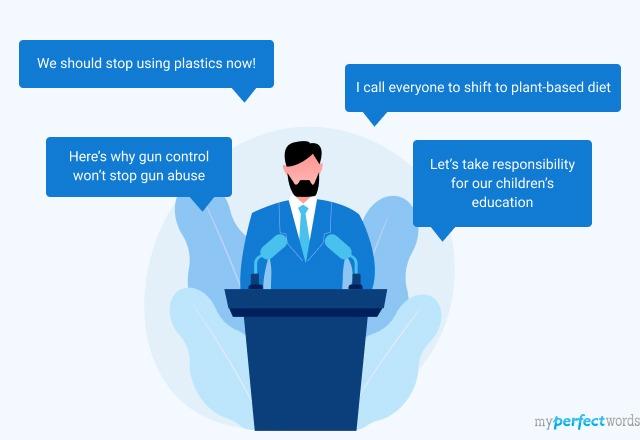
People also read
Making Persuasive Speech Writing Easy: Steps and Tips
Good Persuasive Speech Topics & Ideas for Debaters
Top Motivational Speech Topics and Ideas
Persuasive Speech Outline - Samples, Format, and Writing Tips
3 Basic Types of Persuasive Speeches
Persuasive speech is a type of speech where the speaker tries to convince the audience of his point of view.
For most people, writing and delivering a persuasive speech can seem difficult. However, with the help of examples and some good tips, you can write an effective speech.
In this blog, you can find some amazing examples that you can use to follow and take inspiration. You can easily download and read these examples whenever you need help with writing your persuasive speech.
So, let’s read on!
- 1. Good Persuasive Speech Examples
- 2. How to Start a Persuasive Speech Examples
- 3. How to Write a Persuasive Speech - Examples
- 4. Persuasive Speech Outline Examples
- 5. Persuasive Speech Examples for High School Students
- 6. Persuasive Speech Examples for College Students
- 7. Short Persuasive Speech Examples for Students
- 8. Funny Persuasive Speech Examples
- 9. Motivational Persuasive Speech Examples
- 10. Good Persuasive Speech Topics
Good Persuasive Speech Examples
Picking an interesting and engaging topic for your persuasive speech is crucial. With the help of some good persuasive speech examples, you can easily get through the persuasive speech writing process.
Here are some good persuasive speech examples that will help you get inspired. Get help from these examples and save yourself time.
Famous Persuasive Speech Examples
Policy Persuasive Speech Examples
How to Start a Persuasive Speech Examples
After hours of writing and practicing, here comes a time for delivering the speech. As soon as you start your speech, you notice that people are talking to each other, checking their phones, changing seats, and doing everything but paying attention to you.
Why is that?
That might be because of your boring and mundane start to the speech. The beginning of your speech decides how long the audience will tune into your speech. If you don’t get them interested in your speech right from the start, there are few chances that they will pay attention to your message.
Here is an example speech that demonstrates how to begin your speech effectively:
How to Start a Speech Example
Apart from the technique used in this example, here are five effective ways to kick-start your speech:
- Start With a Famous Quote
Opening with a famous and relevant quote helps you make a good impression on the audience’s mind. It helps you set the tone for the rest of your speech.
For example: “Give Me Liberty or Give Me Death” – Patrick Henry
- Ask a Rhetorical Question
Asking a rhetorical question at the beginning of your speech arouses the audience's curiosity. It is an effective way of engaging and understanding your audience.
For example: “Do you want to be a failure for the rest of your life?”
- Make a Shocking Statement
You can start with a shocking statement by keeping the audience guessing what you are about to say next. A shocking or interesting statement gets people immediately involved and listening to your every word.
For example: "Imagine a world where the air we breathe is more expensive than the food we eat."
- Create a ‘what If’ Scenario
Asking a ‘what if’ question makes the audience follow your thought process. They immediately start thinking about what could be the answer to your ‘what if’ scenario.
For example: “What if we don’t wake up tomorrow? How different are we today?”
- Use a Surprising Statistic
A surprising statistic that resonates with your audience helps you get your message across right away. Real, shocking statistics have the potential to trigger the audience’s emotional appeal.
For example: "Did you know that 7.5 million plastic bottles are discarded every hour in the United States?"
By following any of these tips, you can easily grab the audience’s attention every time.
How to Write a Persuasive Speech - Examples
Persuasive speech writing is an interesting task if you are familiar with the steps. This speech example demonstrates how to write a speech step by step. Use this example to write a successful persuasive speech that is both interesting and appealing to the audience.
How to Write a Persuasive Speech Example
Persuasive Speech Outline Examples
The standard persuasive speech outline consists of an introduction, body, and conclusion. Making a well-structured outline for your speech is the best way to ensure success.
Here is an outline example to help you structure your speech.
Persuasive Speech Outline Template PDF
Persuasive Speech Examples for High School Students
Speech writing and speech competition are common activities in schools. It helps students learn and enhance their public speaking skills and critical thinking.
Here are some persuasive speech examples for high school-level students.
Persuasive Speech Example for High School
Persuasive Speech Example for Highschool Students
Persuasive Speech Examples for College Students
If you are a college student looking for an example to help with your persuasive speech, look no further. Check out these examples below.
Persuasive Speech Examples College
Persuasive Speech Examples About Social Media
Short Persuasive Speech Examples for Students
In most cases, the speaker has limited time to deliver their speech. The following short persuasive examples show speeches that are written with specific time limits in mind. These will help you understand how long your speech should be for an allotted time.
3 Minute Persuasive Speech Example PDF
2 Minute Persuasive Speech Example
Short Persuasive Speech Examples About Life (PDF)
5 Minute Persuasive Speech Example
Funny Persuasive Speech Examples
Persuasive speeches often deal with serious topics. However, they can be for fun and entertainment as well! Here is an example of a funny, persuasive speech.
Funny Persuasive Speech Example
Motivational Persuasive Speech Examples
A motivational speech is a type of persuasive speech where the speaker intended to motivate the audience.
Below are some motivational persuasive speech examples.
Motivational Speech Example
Call to Action Persuasive Speech
Finally, here’s a persuasive speech example from real life. You can watch this persuasive TED talk that aims to convince the audience to quit social media:
Good Persuasive Speech Topics
Now that you’ve checked out some examples, you are ready to start writing your own persuasive speech. But what should you write about? Here are some amazing persuasive speech ideas for you.
- The shift to sustainable transportation is long overdue.
- Adopting a plant-based diet is the best way to ensure personal and environmental well-being.
- Promoting financial literacy education is the key to economic empowerment.
- Raising the minimum wage is a necessity for livable incomes.
- Opt-out organ donation can save more lives.
- Food deserts must be confronted to ensure equal access to healthy nutrition.
- Individual responsibility plays a crucial role in fighting climate change.
- Social media's negative impact on mental health is widespread.
- Stricter gun control measures are vital for balancing Second Amendment rights with public safety.
- Shifting to sustainable energy sources is an urgent matter.
Need more ideas? Check out 250+ persuasive speech topics to find the best topic for your speech.
To Conclude,
With the help of these examples, you can deliver a captivating address to persuade the audience listening to your speech.
However, remember that only having a great topic and structured outline is not enough. You should establish an emotional connection, maintain proper body language, and support your arguments with facts to make a successful speech.
Moreover, if you need help from experts, we’ve got you covered. Our fast essay writing service is experienced in providing perfect speeches within your deadline. Also, we craft unique persuasive speeches from scratch, according to your custom requirements.
So buy speech from professional writers today!

Write Essay Within 60 Seconds!

Cathy has been been working as an author on our platform for over five years now. She has a Masters degree in mass communication and is well-versed in the art of writing. Cathy is a professional who takes her work seriously and is widely appreciated by clients for her excellent writing skills.

Paper Due? Why Suffer? That’s our Job!
Keep reading


Persuasive Writing: 20 Examples, 10 Analyses and Various Teaching Resources
Persuasive writing has long since played into our everyday lives, influencing our decisions on tasks as minor as selecting a shampoo product and as significant as voting for the president. If we look closely, examples of persuasive writing exist everywhere.
Enlist the help of an Engram's Paraphraser to enhance the clarity and eloquence of your writing, as persuasive writing only works with high-quality writing.
And rightfully so, people view persuasive writing as an important factor in their choices. In a study by Manifest, it was found out that " 50% of a group of people said a company's slogan is the brand element that helps them understand the company's purpose the most, [as opposed to] the company's name (13%). "
So, how can we write persuasively and influence decisions? Let's start with the basics. For one to become a good writer, one should read examples of good writing. Hence, if one wants to be a persuasive writer, one should read more examples of persuasive essays and speeches.
In this blog post, we provide famous examples of persuasive writing, analyze each one, and offer a variety of resources that can help improve your persuasive writing skills or that can be given to students in a persuasive writing class.
Table of content
What is persuasive writing, what are the ten most famous examples of persuasive writing, persuasive speech examples, persuasive essay examples, persuasive writing techniques.
- How to start a persuasive essay
Grading rubrics
Persuasive writing is a form of writing in which the writer aims to convince the audience to take a certain viewpoint. Persuasive writing employs logical reasoning (logos), evidence (ethos), emotional appeal (pathos), and other specific types of persuasion techniques to influence the audience.
We will divulge a later section on the different techniques of persuasive writing.

The following are the ten most famous examples of persuasive writing throughout history. We show excerpts from these persuasive writing examples and analyze the persuasive writing techniques in each specific excerpt.
"I have a dream that one day this nation will rise up and live out the true meaning of its creed: 'We hold these truths to be self-evident, that all men are created equal.' I have a dream that one day on the red hills of Georgia, the sons of former slaves and the sons of former slave owners will be able to sit down together at the table of brotherhood.” - Martin Luther King Jr.
It is no surprise that the first persuasive writing example is the “I Have a Dream” speech by Martin Luther King Jr.
In this particular excerpt, Martin Luther King incorporates pathos and strong imagery to persuade the audience to rise against the wrongs of racial discrimination.
The imagery of “slavery,” “brotherhood,” and “hills” evoke strong visuals of hardship, but also a future in which these unjustified sufferings will soon be replaced with higher ideals of equality and unity.
"Society in every state is a blessing, but Government, even in its best state, is but a necessary evil; in its worst state an intolerable one: for when we suffer, or are exposed to the same miseries BY A GOVERNMENT, which we might expect in a country WITHOUT GOVERNMENT, our calamity is heightened by reflecting that we furnish the means by which we suffer.” - Thomas Pain
The second persuasive writing example is Thomas Paine's pamphlet "Common Sense," which was published in 1776 during the American Revolution.
In this example, Paine uses logos and emotive language to demonstrate that America would be better off without British rule. He uses rational reasoning by saying that the country is no different with a government than without one. When people realize this, they will be overwhelmed with anguish, as they know that they are paying for their suffering.
He uses language such as "calamity" and "evil" to emphasize the uselessness of British rule on the American colonies. This extreme language heightens the feelings of mistrust towards the British government among the American colonists.
"Four score and seven years ago our fathers brought forth on this continent, a new nation, conceived in Liberty, and dedicated to the proposition that all men are created equal. Now we are engaged in a great civil war, testing whether that nation, or any nation so conceived and so dedicated, can long endure. We are met on a great battle-field of that war. We have come to dedicate a portion of that field, as a final resting place for those who here gave their lives that that nation might live. It is altogether fitting and proper that we should do this.” - Abraham Lincoln
Abraham Lincoln’s “Gettysburg Address” speech is the third persuasive writing example.
The speech was delivered during the American Civil War to appeal to the audience's patriotism by honoring the fallen Union soldiers in the Battle of Gettysburg and reaffirming the American ideals of national unity and freedom.
This particular excerpt uses logos with a rhetorical question: "Whether that nation, or any nation so conceived and so dedicated, can long endure." This question challenges the audience to think of the war's purpose, the importance of the nation's ideals, and a nation's endurance.
"Along the shores of the sea, there were many blossoms: the leaves of the bayberry shone with a deep glossy green, and the plumes of the goldenrod were bright against the blue water, but the bees that had once hummed among the blossoms were gone. Their hives, hidden under the eaves of deserted buildings or standing in fields grown up in brambles, were silent. The poison had passed on, but the bees had not returned. As for the few survivors, where could they go in search of food? Into what empty fields could they descend, since the flowering grasses no longer grew?" - Rachel Carson
The fourth persuasive writing example is the “Silent Spring” speech by Rachel Carson.
Carson wrote this book to urge for a reevaluation of pesticide use and for governments and people to take proactive and responsible actions to protect the environment. Rachel Carson uses vivid imagery in this speech. She depicts idyllic images of nature to emphasize that nature is fragile, beautiful, and thus worth safeguarding. She wants people to feel a sense of responsibility to not poison but to protect nature’s delicate splendor for future generations.
“Even though large tracts of Europe and many old and famous States have fallen or may fall into the grip of the Gestapo and all the odious apparatus of Nazi rule, we shall not flag or fail. We shall go on to the end. We shall fight in France, we shall fight on the seas and oceans, we shall fight with growing confidence and growing strength in the air, we shall defend our island, whatever the cost may be. We shall fight on the beaches, landing grounds, in fields and in the streets, we shall fight in the hills; we shall never surrender.” - Winston Churchill
Winston Churchill’s “We Shall Fight on the Beaches” speech is our fifth persuasive writing example. It was delivered in 1940 during World War 2 to rally the British people to resist Nazi aggression.
Churchill uses anaphora and the pronoun "we" to urge for a unified call to action. Anaphora is a rhetorical device that involves the repetition of a word or phrase at the beginning of a sentence. He repeatedly says "We shall fight," prompting people into action and to "fight" for what is right.
"The God that holds you over the pit of hell, much as one holds a spider, or some loathsome insect over the fire, abhors you, and is dreadfully provoked; his wrath towards you burns like fire; he looks upon you as worthy of nothing else, but to be cast into the fire; he is of purer eyes than to bear to have you in his sight; you are ten thousand times more abominable in his eyes, than the most hateful venomous serpent is in ours." - Jonathan Edwards
Our sixth persuasive writing example is Jonathan Edwards's "Sinners in the Hands of an Angry God."
Jonathan uses images of a "spider," a "loathsome insect," and a "pit of hell" to cast the sinners and hell in a repulsive light. He is trying to persuade the audience to always act dutifully towards God, as God will be the one to grant salvation and show kindness.
"Is life so dear, or peace so sweet, as to be purchased at the price of chains and slavery? Forbid it, Almighty God! I know not what course others may take; but as for me, give me liberty, or give me death!"- Patrick Henry
The seventh persuasive writing example is “Give Me Liberty or Give Me Death!” by Patrick Henry .
This speech starts with a rhetorical question: "Is life so dear, or peace so sweet, as to be purchased at the price of chains and slavery?" This rhetorical question directly engages the audience, making them ponder whether life is truly sweet if slavery is the price to pay for it. It appeals to our rationality; hence, it employs a technique known as logos.
He also appeals to authority by incorporating "God" into his cry for what is right. By adding a religious figure such as God, he is validating his claims in a moral light.
"That on the first day of January, in the year of our Lord one thousand eight hundred and sixty-three, all persons held as slaves within any State or designated part of a State, the people whereof shall then be in rebellion against the United States, shall be then, thenceforward, and forever free..."- Abraham Lincoln
Abraham Lincoln's "Emancipation Proclamation" is an executive order rather than a piece of persuasive writing, but the order uses a lot of persuasive writing techniques to promote the abolition of slavery.
Lincoln used logos to legally justify his decision as the Commander-in-Chief of the United States to abolish slavery. He also purposefully states the number "one thousand eight hundred and sixty-three" to make his writing appear precise. This precision provides more impact as the writing seems clear and direct.
"We hold these truths to be self-evident: that all men and women are created equal; that they are endowed by their Creator with certain inalienable rights; that among these are life, liberty, and the pursuit of happiness; that to secure these rights governments are instituted, deriving their just powers from the consent of the governed." - Elizabeth Cady Stanton
"Declaration of Sentiments" by Elizabeth Cady Stanton is our ninth persuasive writing example.This speech persuades the audience to support the virtues of the women's rights movement.
In this particular excerpt, Stanton shows her authority by quoting from the Declaration of Independence. She uses the quote "all men and women are created equal" to emphasize that women are also deserving of rights because they are equal to men. This logical progression substantiates her claim both logically and legally.
“Yesterday, December 7th, 1941—a date which will live in infamy—the United States of America was suddenly and deliberately attacked by naval and air forces of the Empire of Japan. The United States was at peace with that nation, and, at the solicitation of Japan, was still in conversation with its government and its emperor looking toward the maintenance of peace in the Pacific.” - Franklin D. Roosevelt
“Day of Infamy” by Franklin D. Roosevelt is the last example of persuasive writing. In this speech, Roosevelt wanted to rile up the public to gain approval of his political response to the Pearl Harbor attack.
Roosevelt uses emotive language, such as "suddenly" and "deliberately attacked," to contrast the peaceful nature of the United States. This contrast highlights the inhumanity of Japan's attack on Pearl Harbor and the United States' innocence; the United States had been blindsided by Japan.
More persuasive writing examples
Here are ten other examples of persuasive writing. Now it's your turn. Use our infographics to analyze why these techniques have been noted in history as successful examples of persuasive writing.
"There are many people in the world who really don't understand, or say they don't, what is the great issue between the free world and the Communist world. Let them come to Berlin. There are some who say that Communism is the wave of the future. Let them come to Berlin. And there are some who say, in Europe and elsewhere, we can work with the Communists. Let them come to Berlin. And there are even a few who say that it is true that Communism is an evil system, but it permits us to make economic progress. Lass' sie nach Berlin kommen. Let them come to Berlin." - John F. Kennedy
"We welcome change and openness; for we believe that freedom and security go together, that the advance of human liberty can only strengthen the cause of world peace. There is one sign the Soviets can make that would be unmistakable, that would advance dramatically the cause of freedom and peace. General Secretary Gorbachev, if you seek peace, if you seek prosperity for the Soviet Union and Eastern Europe, if you seek liberalization, come here to this gate. Mr. Gorbachev, open this gate. Mr. Gorbachev, tear down this wall!" - Ronald Reagan
"I have done whatever I did, both as an individual and as a leader of my people, because of my experience in South Africa and my own proudly felt African background, and not because of what any outsider might have said. In my youth in the Transkei, I listened to the elders of my tribe telling stories of the old days. Amongst the tales they related to me were those of wars fought by our ancestors in defence of the fatherland. The names of Dingane and Bambatha, Hintsa and Makana, Squngthi and Dalasile, Moshoeshoe and Sekhukhuni, were praised as the glory of the entire African nation. I hoped then that life might offer me the opportunity to serve my people and make my own humble contribution to their freedom struggle. This is what has motivated me in all that I have done in relation to the charges made against me in this case." - Nelson Mandela
"It was we, the people; not we, the white male citizens; nor yet we, the male citizens; but we, the whole people, who formed the Union. And we formed it, not to give the blessings of liberty, but to secure them; not to the half of ourselves and the half of our posterity, but to the whole people—women as well as men. And it is downright mockery to talk to women of their enjoyment of the blessings of liberty while they are denied the use of the only means of securing them provided by this democratic-republican government—the ballot." - Susan B. Anthony
"Indifference is not a response. Indifference is not a beginning; it is an end. And, therefore, indifference is always the friend of the enemy, for it benefits the aggressor — never his victim, whose pain is magnified when he or she feels forgotten. The political prisoner in his cell, the hungry children, the homeless refugees — not to respond to their plight, not to relieve their solitude by offering them a spark of hope is to exile them from human memory. And in denying their humanity, we betray our own." - Elie Wiesel
"By a faction, I understand a number of citizens, whether amounting to a majority or a minority of the whole, who are united and actuated by some common impulse of passion, or of interest, adverse to the rights of other citizens, or to the permanent and aggregate interests of the community." - James Madison
"Well, children, where there is so much racket there must be something out of kilter. I think that 'twixt the negroes of the South and the women at the North, all talking about rights, the white men will be in a fix pretty soon. But what's all this here talking about? That man over there says that women need to be helped into carriages, and lifted over ditches, and to have the best place everywhere. Nobody ever helps me into carriages, or over mud-puddles, or gives me any best place! And ain't I a woman? Look at me! Look at my arm! I have ploughed and planted, and gathered into barns, and no man could head me! And ain't I a woman? I could work as much and eat as much as a man—when I could get it—and bear the lash as well! And ain't I a woman? I have borne thirteen children, and seen most all sold off to slavery, and when I cried out with my mother's grief, none but Jesus heard me! And ain't I a woman?" - Sojourner Truth
"What, to the American slave, is your 4th of July? I answer; a day that reveals to him, more than all other days in the year, the gross injustice and cruelty to which he is the constant victim. To him, your celebration is a sham; your boasted liberty, an unholy license; your national greatness, swelling vanity; your sounds of rejoicing are empty and heartless; your denunciations of tyrants, brass fronted impudence; your shouts of liberty and equality, hollow mockery; your prayers and hymns, your sermons and thanksgivings, with all your religious parade and solemnity, are, to him, mere bombast, fraud, deception, impiety, and hypocrisy—a thin veil to cover up crimes which would disgrace a nation of savages. There is not a nation on the earth guilty of practices more shocking and bloody than are the people of these United States at this very hour." - Frederick Douglass
"The word Fascism has now no meaning except in so far as it signifies 'something not desirable.' The words democracy, socialism, freedom, patriotic, realistic, justice, have each of them several different meanings which cannot be reconciled with one another. In the case of a word like democracy, not only is there no agreed definition, but the attempt to make one is resisted from all sides. It is almost universally felt that when we call a country democratic we are praising it: consequently the defenders of every kind of regime claim that it is a democracy, and fear that they might have to stop using the word if it were tied down to any one meaning. Words of this kind are often used in a consciously dishonest way. That is, the person who uses them has his own private definition, but allows his hearer to think he means something quite different." - George Orwell
"The problem lay buried, unspoken, for many years in the minds of American women. It was a strange stirring, a sense of dissatisfaction, a yearning that women suffered in the middle of the twentieth century in the United States. Each suburban wife struggled with it alone. As she made the beds, shopped for groceries, matched slipcover material, ate peanut butter sandwiches with her children, chauffeured Cub Scouts and Brownies, lay beside her husband at night—she was afraid to ask even of herself the silent question—'Is this all?'" - Betty Friedan
Here are some of the most effective persuasive writing techniques. Feel free to use the information and infographics in the classroom or for your own use.
Another resource is Engram's Grammar Checker and Paraphraser. Engram's AI tools are optimized to elevate your English to its full potential. Click the button below and write away, worry-free and with ease.

How to start a persuasive speech and essay
Below is a step-by-step infographic on how to write a persuasive speech and essay. Feel free to use the information and infographic in the classroom or for your own use.
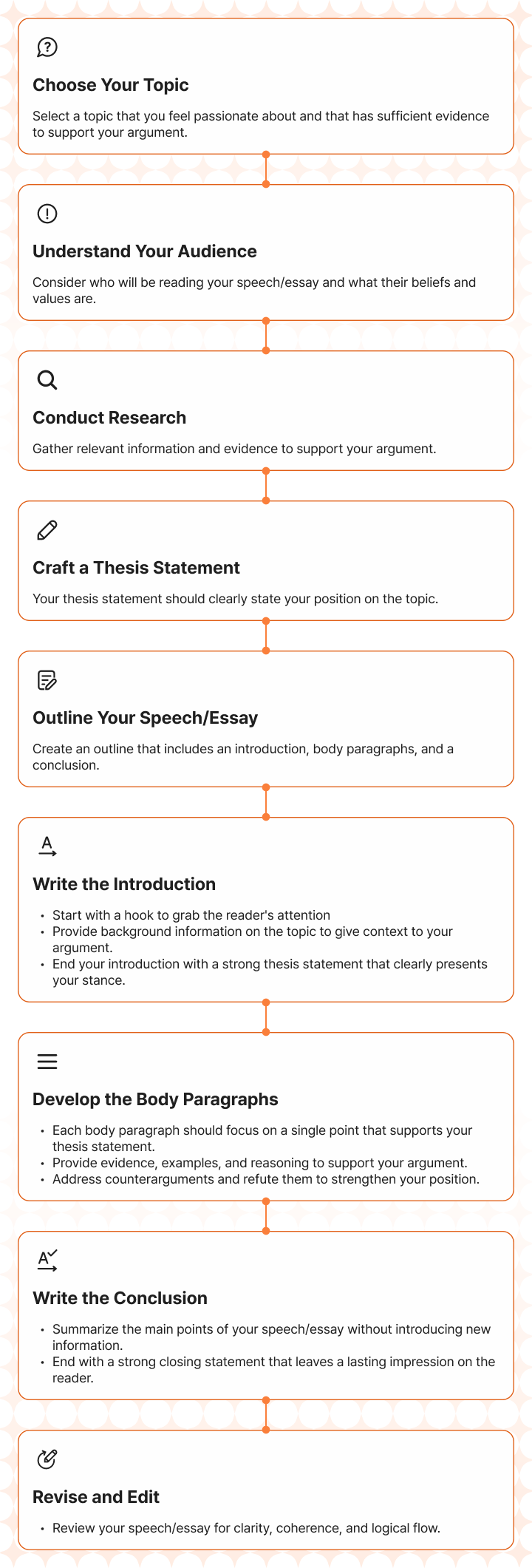
Feel free to use these worksheets in the classroom or for your own use.
Persuasive speech
Persuasive essay.
Below, we have provided example rubrics to grade persuasive speeches and essays. Feel free to use or modify these rubrics in the classroom or for your own use.
Writing a persuasive essay requires careful planning, strong evidence, and compelling arguments to sway your audience to your viewpoint.
By following the strategies outlined in this blog post, you can craft compelling essays that effectively persuade your readers to embrace any viewpoint. So, whether you're advocating for a political stance, promoting a social cause, or arguing for a particular policy, use these techniques to make your or your student's voice heard and influence change.

Check out Engram's Grammar Checker to level up your English and ensure that grammatical and punctuation errors do not get in the way of your persuasion skills. Write away with confidence!
References:
Share Article

SciSpace vs. Engram: Is SciSpace the Best Online Paraphrasing Tool for Scholars?
Languagetool vs. engram: which is the better paraphrasing tool for non-native speakers (2024).
- Self Confidence
- Public Speaking
- Communication
- Communication Skills
LEARNER STORIES
- Kanhaiya Sharma
- Ashfaq Sorathia
- Prateek Chawla
OTHER TOOLS
- Comparative Analysis
On This Page
In a world brimming with information, persuasion is a valuable skill. Whether you’re a marketer aiming to sway consumers, a politician seeking votes, or a writer hoping to engage and inform, persuasive writing is your secret weapon. It’s the art of crafting words and arguments that convince, influence, and inspire action, presenting many persuasive writing examples to underscore your viewpoint.
Have you ever wondered what sets persuasive writing apart from the rest? How does it work, and why is it so powerful? In this blog, we’ll delve deep into the world of writing persuasive essays, exploring its techniques, psychology, and real-world applications, including persuasive writing examples. When you finish reading, you’ll understand the fundamentals and have the tools to apply persuasive writing in your endeavors.
So, let’s embark on a journey into the realm of words and ideas, where the power of persuasion awaits. Join us as we uncover the strategies and secrets behind compelling narratives and convincing arguments and learn how to master the art of persuasive writing.
Understanding Persuasive Writing
Persuasive writing is an art that shapes our decisions, beliefs, and actions daily. Whether convincing a friend to try a new restaurant, supporting a political candidate, or buying a product, persuasive elements are ever-present. To master persuasive writing, it’s crucial to comprehend the underlying psychology that drives it.
writers must understand how people think and make choices. One of the key foundations of writing persuasive essays is Aristotle’s three modes of persuasion: ethos, pathos, and logos. These principles are the building blocks of effective communication. Understanding and utilizing persuasive writing examples that incorporate ethos (ethical appeal), pathos (emotional appeal), and logos (logical appeal) can significantly enhance the impact of persuasive writing by appealing to the audience’s emotions, ethics, and reasoning.
Ethos involves establishing the credibility and authority of the speaker or writer. It’s about showcasing your expertise, trustworthiness, and authority on the subject matter. An audience is more likely to be persuaded by someone they perceive as a credible source. Exploring persuasive writing examples that effectively utilize ethos can provide a deeper understanding of how credibility and authority are established to influence an audience.
Pathos taps into emotions. It’s about crafting your writing to resonate with your audience’s feelings, values, and desires. Emotional appeal can be a potent tool in persuasion to convince the reader, as it forges a connection with readers on a personal level.
Logos employs logic and reasoning. It involves using evidence, data, and well-structured arguments to support your claims. A logically sound argument can bolster your persuasive efforts, especially when dealing with a rational or analytical audience.
In addition to these three principles, it’s important to recognize the role of cognitive biases in persuasion. Human brains often take cognitive shortcuts, resulting in biases that influence decision-making. By understanding these biases, such as confirmation bias, anchoring, and the bandwagon effect, writers can strategically shape their persuasive content to convince the reader to work with, rather than against, these cognitive tendencies.
Furthermore, the power of storytelling should not be underestimated. People are naturally drawn to write narratives. A well-told story can captivate, resonate, and persuade better than a dry recitation of facts. By weaving persuasive elements into a compelling narrative, writers can engage their audience on a deep, emotional level.
Persuasive Writing in Professional Life
Effective writing to write persuasive content is a versatile and significant tool in numerous professional scenarios. Whether in a corporate setting or freelancing, knowing how to wield the power of words can greatly enhance your career prospects and bring about desired outcomes. Here are five situations where persuasive writing is particularly effective:
1. Marketing and Advertising Campaigns

To write persuasive essays lies at the core of marketing and advertising efforts. Crafting compelling and engaging copy that resonates with the target audience can persuade consumers to purchase products, subscribe to services, or take specific actions. Successful marketers use persuasive language, storytelling, and emotion-evoking content to connect strongly with potential customers.
2. Business Proposals and Reports
When presenting business proposals, reports, or recommendations, a persuasive essay can make a substantial difference. Convincing stakeholders or decision-makers to endorse your ideas, allocate resources, or support your strategies often hinges on how effectively you can articulate the benefits and potential returns on investment.
3. Sales Emails and Correspondence

Sales professionals and account managers frequently employ persuasive writing techniques in their emails and client communication. Skillful use of persuasive language, personalized content, and the presentation of unique selling points can win over potential clients, retain existing customers, and close deals.
4. Job Applications and Resumes

In the competitive job market, a persuasive essay is vital for crafting attention-grabbing resumes and compelling cover letters. The ability to present your skills, experiences, and qualifications persuasively can help you stand out among a sea of applicants, ultimately securing interviews and job offers.
5. Public Relations and Crisis Management
Persuasive writing plays a crucial role in managing public relations and handling crises. Communicating effectively during challenging situations requires language that can restore trust, mitigate damage, and convey a sense of responsibility and accountability.
As we’ve explored the power of persuasive writing in professional life, let’s now delve into crafting a persuasive message for specific scenarios.
Crafting A Persuasive Message
Creating a persuasive message is an art that combines the mastery of language, psychology, and strategy. To write a great persuasive message, you need to consider various elements and techniques that can captivate and influence your audience effectively. Here are some techniques how:

Establish Compelling Statement
Your persuasive message should begin with a concise and powerful thesis statement. This statement serves as the core idea you want to convey to your audience. It should be clear, specific, and easily understood. For example, suppose you’re writing a persuasive essay on the importance of recycling. In that case, your thesis statement might be: “Recycling reduces waste and conserves resources, making it an essential practice for a sustainable future.”
Structure Your Arguments
The structure of your message plays a crucial role in how persuasive it is. Arrange your arguments logically, beginning with the strongest points and gradually leading to the supporting details. This structure not only reinforces your main thesis but also ensures your audience remains engaged. An effective structure guides the reader from their initial skepticism to a point of agreement or action.
Use Persuasive Language
Employ persuasive language and rhetorical devices to make your message more convincing. These include metaphors, analogies, vivid imagery, and emotionally charged words. For example, in a persuasive speech advocating for better healthcare access, you could use the metaphor, “Healthcare is the cornerstone of a strong, healthy society,” to evoke a powerful image.
Address Counterarguments
Acknowledging and addressing potential counterarguments in your message demonstrates that you’ve thoroughly considered the issue. Anticipating and refuting opposing viewpoints adds credibility to your argument and reassures your audience. For instance, if you’re advocating for a particular environmental policy, address common objections and provide compelling counterarguments to debunk them.
Engage Reader’s Emotions
One of the most powerful tools in persuasive writing is emotional appeal. Engage your audience’s emotions by telling relatable stories, sharing personal anecdotes, or using emotional language. Suppose you’re writing a persuasive message to encourage donations to a charitable cause. In that case, a heartwarming story about a beneficiary can resonate deeply with your readers and inspire them to take action.
Having discussed the art of crafting a persuasive message, let’s now shift our focus to the broader skill of developing persuasive writing for various professional contexts.
Developing Persuasive Writing
Mastering the art of persuasive writing requires practice, dedication, and a deep understanding of the key principles and techniques. Here are some essential steps to help you develop persuasive writing skills:

Understanding Your Audience
Start by researching your target audience. Understand their demographics, interests, and the concerns. Engage with your readers or listeners to gain insights into what motivates them and what matters most to them. Use surveys, social media, and other feedback mechanisms to gather information. Once you have a clear understanding of your audience, tailor your writing to address their specific needs and the desires. Speak directly to their concerns, values, and goals. Use language and examples of persuasive essays and writing that resonate with them, demonstrating empathy and a deep connection.
Compelling Storytelling
Study the art of storytelling. Read books and articles and listen to speakers known for their storytelling skills. Practice storytelling in various contexts, from personal anecdotes to fictional narratives. Weave stories into your writing to illustrate key points and connect with your readers emotionally. Craft narratives that evoke feelings and provide relatable examples of persuasive storytelling. A well-told story enhances the impact of your message.
Call To Action
Study successful examples of persuasive calls to action in various contexts, from marketing campaigns to political speeches. Understand the elements that make a call to action compelling and actionable. Practice creating calls to action in different scenarios. Conclude your piece with a strong and specific call to action. Clearly state what you want your readers to do, believe, or think after reading your content. Make it actionable and inspiring, motivating your audience to engage or take the desired steps.
Impact Of Persuasive Writing: Examples
The impact of persuasive essays extends far beyond the written words on a page or screen. It can potentially effect significant change, influence decisions, and shape opinions in various domains. Here’s a closer look at the profound impact of persuasive writing:

Shaping Public Opinion
Persuasive writing is a formidable force in shaping public opinion and influencing policy. Op-eds, research papers, and advocacy campaigns can sway lawmakers, prompting them to adopt new laws or regulations in alignment with the writer’s perspective. Additionally, a persuasive essay has a significant impact on how the public perceives issues, organizations, or individuals. Media outlets, public relations campaigns, and persuasive speeches play a vital role in generating both positive and negative public perceptions, which, in turn, can affect public behavior, from supporting a cause to boycotting a product.
Greta Thunberg’s Climate Change Speech (2019)
Greta Thunberg’s speeches on climate change have ignited a global movement. Her speeches are characterized by their passionate and urgent pleas for environmental action (pathos). Thunberg’s use of moral and ethical arguments, reinforced by her ethos as a young environmental activist, has spurred climate strikes and rallies worldwide, leading to increased awareness and calls for policy changes.
Effective Leadership
Persuasive writing is an indispensable tool for effective leadership. Leaders across various domains use persuasive communication to motivate their teams. Whether through an inspirational email, a compelling speech, or a well-structured persuasive essay, compelling writing fosters a shared sense of purpose, drives high performance, and encourages team members to embrace a common vision. Additionally, leadership’s persuasive writing plays a fundamental role in shaping an organization’s culture. By communicating core values, vision, and expectations through written messages, leaders contribute to a cohesive and thriving workplace culture, positively impacting team dynamics and overall success.
Barack Obama’s 2008 Inaugural Address
In his inaugural address, President Barack Obama used eloquent language and a message of hope and unity to inspire the nation. He appealed to the audience’s emotions (pathos) by emphasizing common values and dreams, fostering a sense of national purpose and unity (ethos).
Motivating Action
Persuasive writing is a catalyst for motivating action on multiple fronts. It is a driving force behind social change, as activists, NGOs, and grassroots organizations use persuasive content to mobilize individuals to take action, whether signing petitions, participating in rallies, or donating to causes they believe in. Additionally, persuasive essays are instrumental in personal growth and development. Self-help books, motivational articles, and life coaching resources harness persuasive language to inspire people to adopt positive behaviors, set and achieve goals, and lead healthier, more fulfilling lives.
Emma Gonzalez’s “We Call B.S.” Speech (2018)
Emma Gonzalez, a survivor of the Marjory Stoneman Douglas High School shooting, delivered a passionate speech advocating for gun control. Her speech combined personal anecdotes and data-driven arguments (logos) to emphasize the need for policy changes. The emotional impact of her speech (pathos) resonated with many and fueled the gun control movement, contributing to legislative reforms and activism.
Empower Yourself With Persuasion
In an era of information overload and constant communication, the ability to wield persuasive communication is a powerful tool that can transform your personal and professional life, so empower yourself with persuasion. Acquire the skills to express your ideas effectively, build authentic connections, and drive positive change. With the art of persuasion in your toolkit, you hold the key to leaving a lasting mark on the world and shaping your unique history.
By Rishabh Bhandari
How to give a persuasive presentation: techniques and proven framework, influence vs persuasion: what’s the real difference, what is persuasion: meaning, skills and examples.
Kapable © 2024
- TERMS OF USE
- PRIVACY POLICY

IMAGES
VIDEO
COMMENTS
Persuasive Speech Writing Examples. Many persuasive speeches are political in nature, often addressing subjects like human rights. Here are some of history's most well-known persuasive writing examples in the form of speeches. I Have a Dream by Dr. Martin Luther King Jr.
How to write a persuasive speech. Incorporate the following steps when writing a persuasive speech: Step 1 - Identify the type of persuasive speech (factual, value, or policy) that will help accomplish the goal of the presentation. Step 2 - Select a good persuasive speech topic to accomplish the goal and choose a position. How to write a persuasive speech
Persuasive Speech Outline, with Examples. A persuasive speech is a speech that is given with the intention of convincing the audience to believe or do something. This could be virtually anything - voting, organ donation, recycling, and so on. A successful persuasive speech effectively convinces the audience to your point of view, providing ...
Reason 3 ( Provide one reason as to why listeners should act or think the way your thesis suggests.) Example 1 - Support for the reason given above. Example 2 - Support for the reason given above. The most important part of a persuasive speech is the conclusion, second to the introduction and thesis statement.
Persuasive speeches have been used throughout history to shape public opinion and shape behavior, and examples abound. Persuasive speech examples include virtually any topic - voting, racism, school uniforms, safety, organ donation, recycling, and so on. From a teenager asking his parents to go out with friends to an aspiring politician ...
Step 2: After the Story, Now, Give Your Advice. When most people write a persuasive presentation, they start with their opinion. Again, this makes the listener want to play Devil's advocate. By starting with the example, we give the listener a simple way to agree with us.
The purpose of a persuasive speech is to convince your audience to agree with an idea or opinion that you present. First, you'll need to choose a side on a controversial topic, then you will write a speech to explain your position, and convince the audience to agree with you. You can produce an effective persuasive speech if you structure your ...
For example, a causal speech explains what happens as a result of a cause. (Source: bizfluent). A comparative advantage speech examines two or more things and explains why some are better than others. ... Part of writing a persuasive speech is creating a persuasive speech outline and writing out your speech. As you're writing out your speech ...
In a persuasive speech, your signposts are typically the problems, causes, and solutions. Example: "Let's first learn more about this pressing problem, next identify the causes of unclean water, and finally establish some solutions." BODY You are now going to write the body of the speech, which consists of problems, causes, and solutions ...
Some persuasive writing examples can help you get a start on your own texts. If you're trying to sway someone towards a certain viewpoint, we can help you. Dictionary ... Check out a short example of a persuasive speech in action. Every day as you walk down Maple St., you might notice the small little garden flourishing under the sunlight. ...
Persuasive Speech is a category of speech that attempts to influence the listener's beliefs, attitudes, thoughts, and ultimately, behavior. They are used in all contexts and situations. It can be informal, a teenager attempting to convince his or her parents for a sleepover at a friend's house. It can also be formal, President or Prime ...
Persuasive Speech Examples Persuasive Speech Example #1: The Case for a Well-Deserved Raise. Boss, I stand before you today with a sense of pride and purpose. Over the past year, my time with the company has been both transformative. I have grown and so, too, has the company.
You can map each point with a respective counterargument using a mind-mapping tool for a structured and more organised approach. #2. Cut down the fluff. How to write a persuasive speech. This is no time to flex your wealth of ultra-complicated technical words. The idea of a persuasive speech is to get your point across verbally.
For assistance with planning and writing. Writing a persuasive speech - a 7 step action plan that includes how to choose a topic, analyze your audience, set a good speech purpose, decide on a structural pattern (with examples) and, more. A persuasive speech outline example using the 5 step structural pattern: Monroe's Motivated Sequence. (With ...
Storytelling. More controversial persuasive speech topics, in particular, will require you to artfully work through various objections and mix different persuasion methods. Now let's take a closer look at each one. 1. Repetition. There's a reason that advertisements repeat the same thing over and over again.
Once you've chosen your persuasive speech topic (our list of 110 riveting persuasive speech ideas is coming next!) and completed your research on the subject, you'll begin the writing process. Use this step-by-step approach to produce an outstanding speech that easily persuades your audience to adopt your viewpoint.
The aim of a persuasive speech is to inform, educate and convince or motivate an audience to do something. You are essentially trying to sway the audience to adopt your own viewpoint. The best persuasive speech topics are thought-provoking, daring and have a clear opinion. You should speak about something you are knowledgeable about and can ...
Persuasive Speech Example #2: A Persuasive Speech on the Topic of Organ Donation. A Persuasive Speech on the Topic of Organ Donation. [1] First of all I would like to thank you the board for inviting me here today, allowing me to be a part of and contributing to this cause that personally means so much to me.
Here are some examples that stick to a single, compelling call to action for a 1-minute window. Short persuasive speech examples. #1. Title: Go Meatless on Mondays. Good afternoon everyone. I'm asking you to join me in adopting a simple change that can positively impact both our health and the planet - going meatless one day a week.
Persuasive speech is a type of speech where the speaker tries to convince the audience of his point of view. For most people, writing and delivering a persuasive speech can seem difficult. However, with the help of examples and some good tips, you can write an effective speech.
Abraham Lincoln's "Gettysburg Address" speech is the third persuasive writing example. The speech was delivered during the American Civil War to appeal to the audience's patriotism by honoring the fallen Union soldiers in the Battle of Gettysburg and reaffirming the American ideals of national unity and freedom.
One of the key foundations of writing persuasive essays is Aristotle's three modes of persuasion: ethos, pathos, and logos. These principles are the building blocks of effective communication. Understanding and utilizing persuasive writing examples that incorporate ethos (ethical appeal), pathos (emotional appeal), and logos (logical appeal ...
Persuasive speech is a powerful tool in raising awareness, promoting empathy, and inspiring positive change in attitudes and behaviors towards bullying. By using persuasive language and compelling arguments, we can engage individuals in meaningful conversations about the harmful effects of bullying and the importance of creating a culture of ...